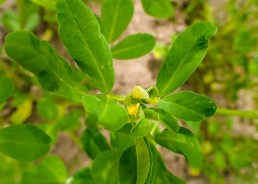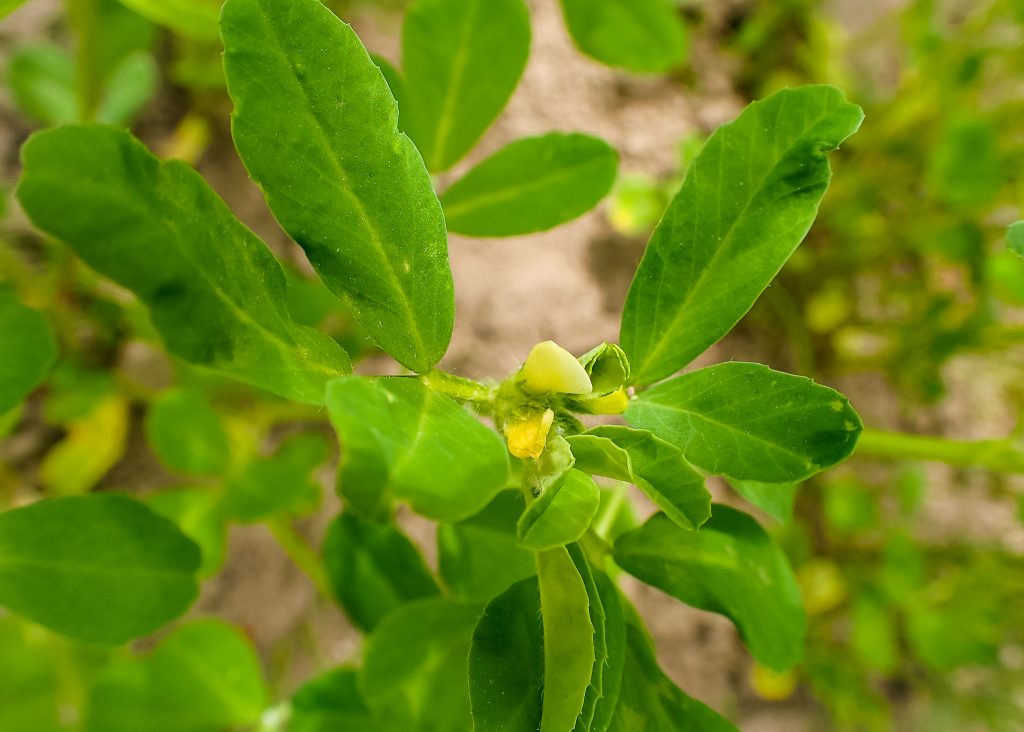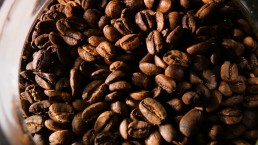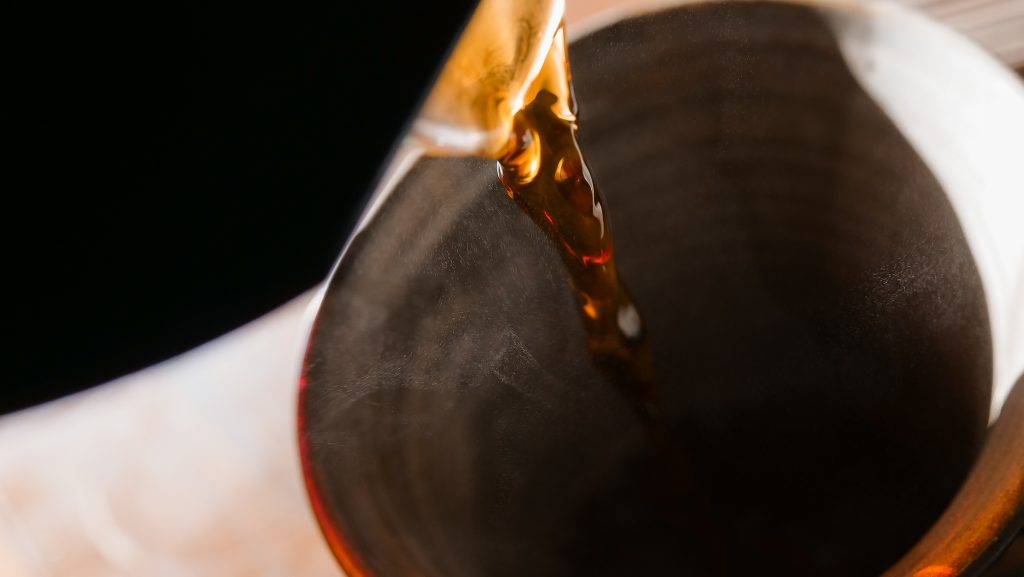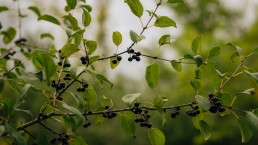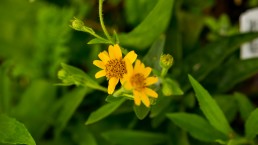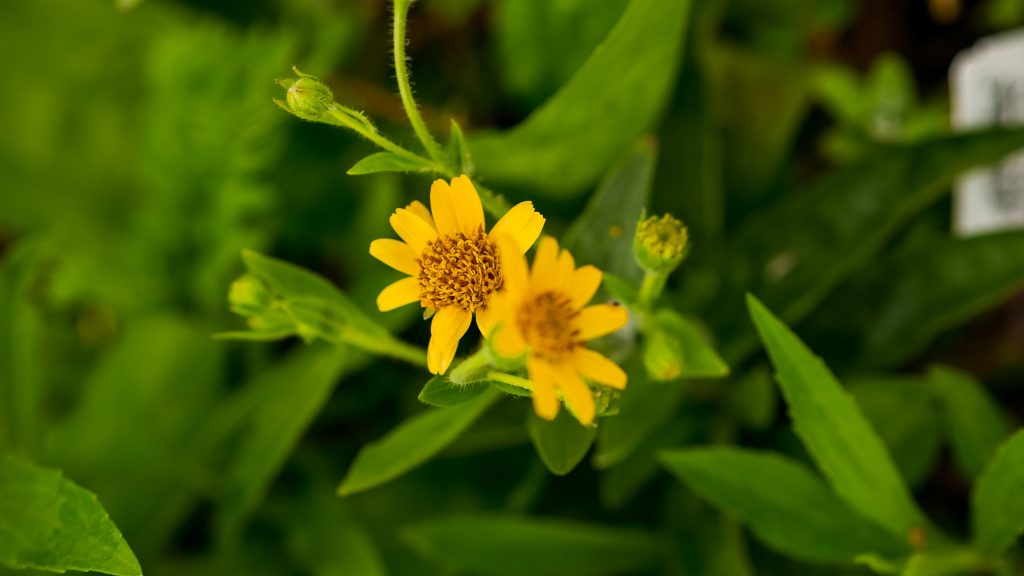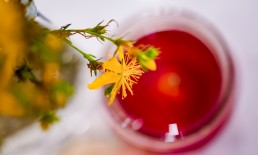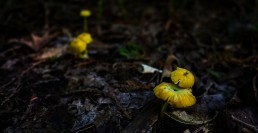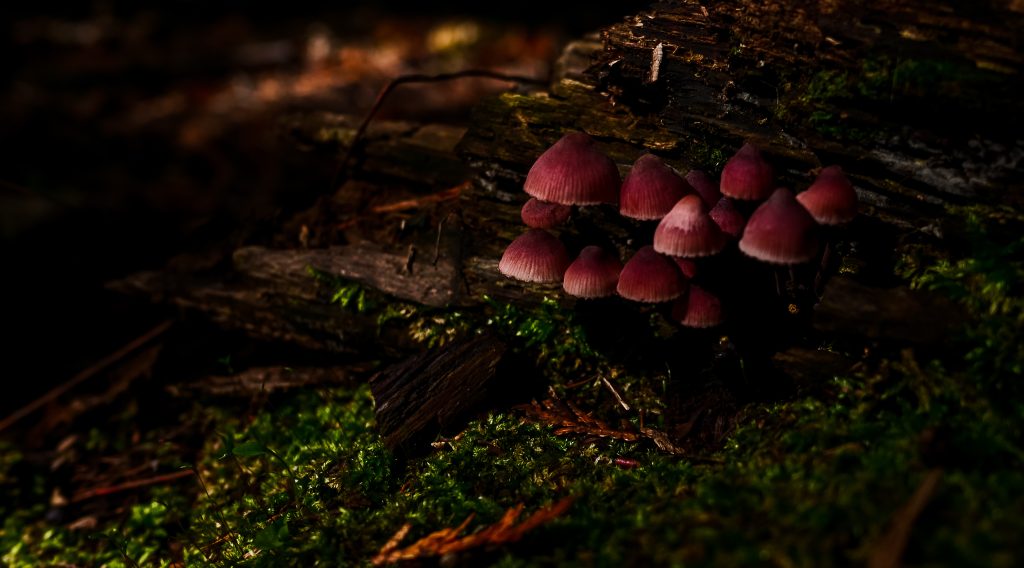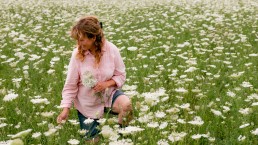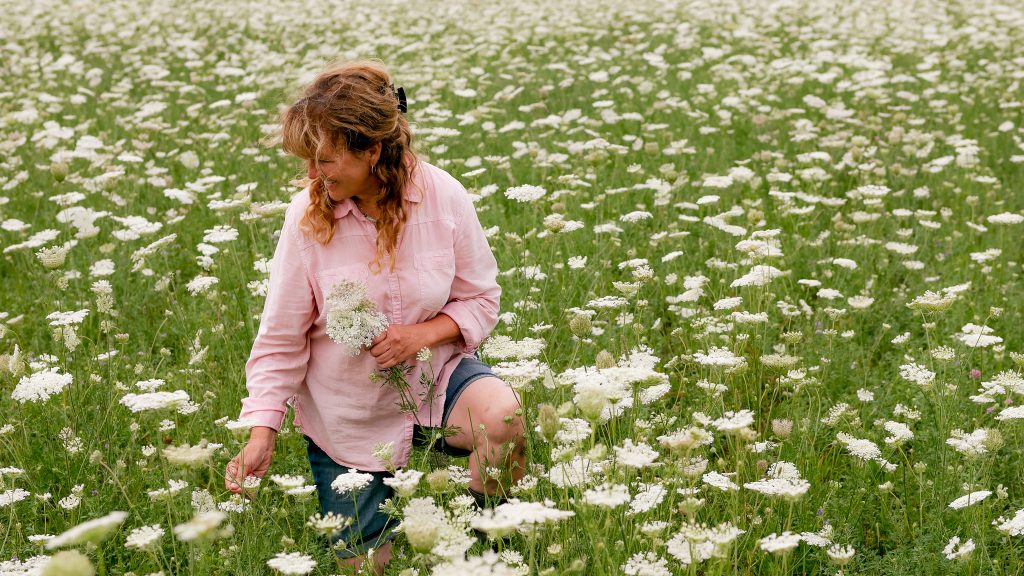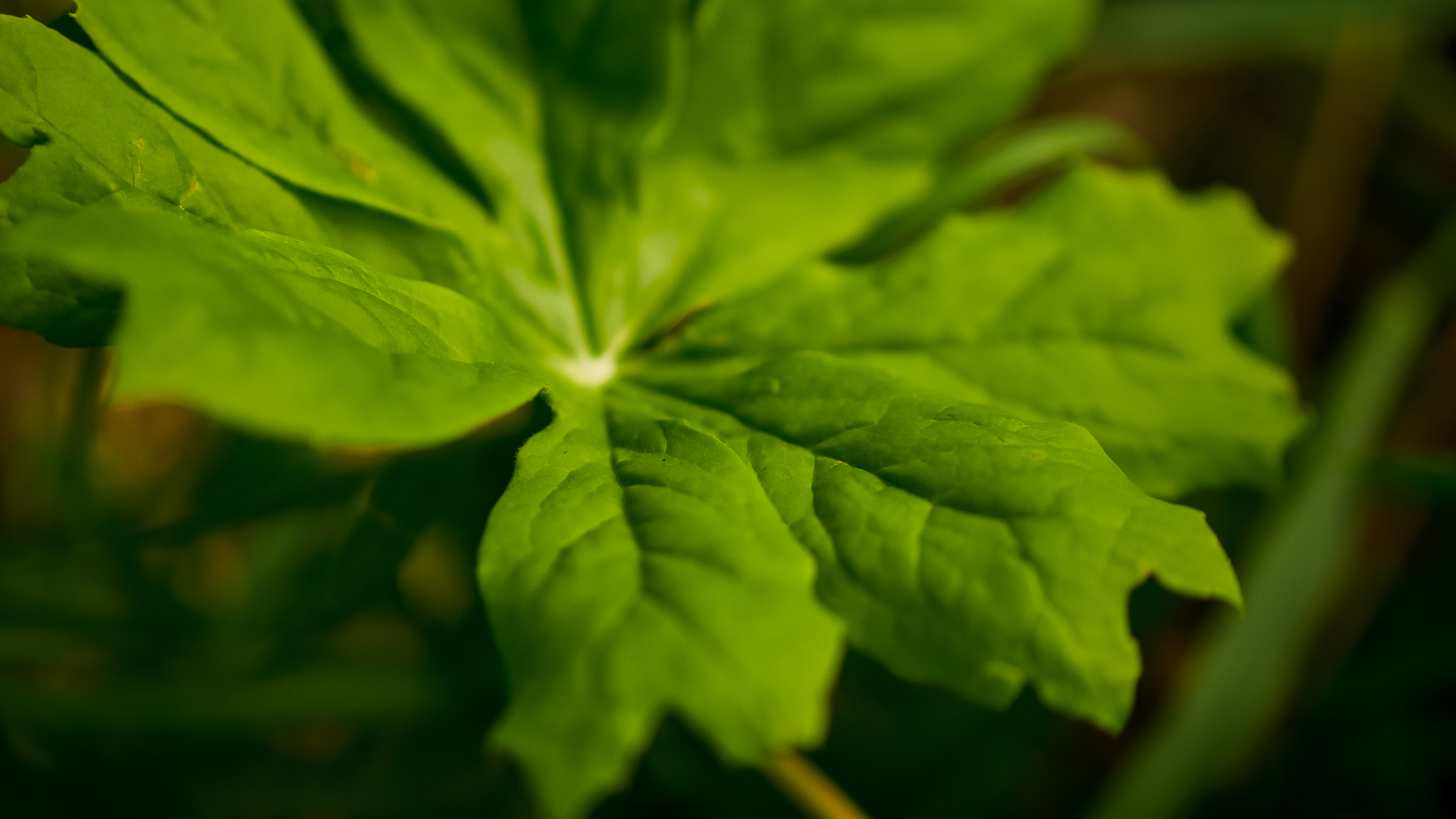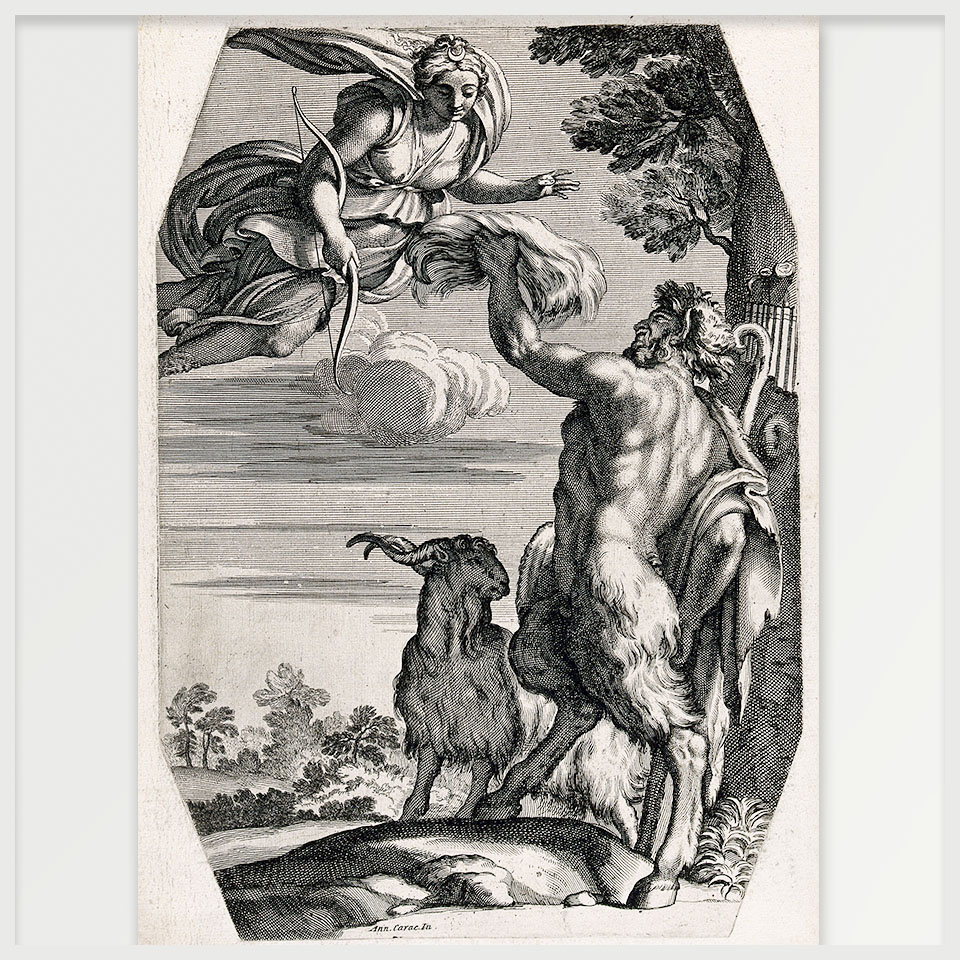Fenugreek: Materia Medica
Trigonella foenum-graecum
Fenugreek is an herb with a long and esteemed history both in medicine and the culinary arts. Some authors suggest that fenugreek originated in India and North Africa, while others suggest that it is indigenous to the eastern Mediterranean region. One of the earliest recorded uses of Fenugreek comes to us by way of Egypt, where it was used in incense making as well as in the process of embalming mummies. Fenugreek, as the name suggests, was widely utilized by the ancient Greeks, for whom it was a staple food. The name foenum-graecum, which literally translates as ‘Greek hay’, refers to the practice of mixing fenugreek with inferior quality hay in order to increase and enhance its scent.
Nutritional and Medicinal Value
As part of its nutritional profile, fenugreek contains considerable amounts of vitamin B and phosphorous compounds (e.g. lecithin), making it a culinary herb with a special affinity for the nervous system (lecithin is a mixture of neutral lipids and phospholipids, which are important constituents of the central nervous system and play a role in promoting and maintaining the health of the brain’s functional pathways). Fenugreek is often added to curries, where it serves to aid and promote healthy digestive function but also helps to prevent gas, bloating, cramping, indigestion, heartburn, and acid reflux in susceptible individuals. Fenugreek contains considerable amounts of iron, and may be well employed in some cases of iron-deficiency anemia: fenugreek helps the body in the process of blood formation. Continuing with the nutritional properties of the herb, Dorothy Hall remarks: “As it also manufactures in its growth vitamin A and a vegetable-form of vitamin D, it is supportive of liver function too, and protective of all mucous-lined body organs. There is much sulphur present; and also choline, and support for cholesterol metabolism” (Hall: 1988, 159). Fenugreek is an herb to consider when dealing with a hypo-functioning liver. In Ayurvedic medicine, fenugreek is recognized as “a good herbal food for convalescence and debility, particularly that of the nervous, respiratory and reproductive systems” (Frawley & Lad: 2001, 190)
Concerning the use of fenugreek as a medicinal herb, Hall provides us with the following overview:
“Its properties may best be summed up as supportive of liver function, protective to mucous- linings all through the body, and giving renewed nervous energy. There is a fourth benefit, however, and one which is becoming more and more necessary today: Fenugreek clears and promotes the drainage of the body by the lymphatic system. As lymphatic vessels and lymph- fluid movement are essential parts of our immune system, Fenugreek may become a valuable plant for the future.” (Hall: 1988, 159)
Fenugreek is likely the most frequently employed herbal galactagogue, meaning that it helps to promote the production of breast milk. It is also widely used in the treatment of diabetes type 1 and 2, where it helps to increase the body’s tolerance for carbohydrates, reduces blood sugar and total LDL cholesterol levels. Fenugreek can be used by men who experience seminal debility (i.e. issues with the quality and quantity of sperm), as well as for erectile dysfunction and low libido (fenugreek contains furostanolic saponins, which have been linked to increased testosterone production). Fenugreek is a lung tonic and has its place in the treatment of asthmatic complaints, as well as lung and sinus congestion. A paste made from fenugreek seeds can be used topically for ailments such as boils, ulcers, burns, and poorly healing sores (Frawley & Lad: 2001, 191). Other traditional indications include: tuberculosis, gout, and generalized body pain.
On the level of herbal energetics, fenugreek is: bitter, pungent, sweet/heating/pungent. It affects the plasma, blood, marrow, nerve and reproductive tissues and has an affinity for the digestive, respiratory, urinary, and reproductive systems (Frawley & Lad: 2001, 191). Fenugreek is a stimulant, especially for a slow-draining lymphatic system and where there are issues with edema and fluid retention. Fenugreek possesses diaphoretic and mild diuretic actions. It also possesses tonic, expectorant, rejuvenative, and aphrodisiac properties.
Works Cited:
Hall, Dorothy. Dorothy Hall’s Herbal Medicine. Melbourne: Lothian Publishing Company, 1988.
Frawley, David & Lad, Vasant. The Yoga of Herbs. Wisconsin: Lotus Press, 2001.
—-
Image Credits:
Krzysztof Ziarnek, Kenraiz: Mildly colour edited version of their original Fenugreek image.
Your Access to Herbal Healthcare in Canada is About to be Permanently Restricted!
Your Access to Herbal Healthcare in Canada is About to be Permanently Restricted
At Everything Herbal, we believe that access to natural healing is an inalienable right of all people. Herbal medicine has been used since time immemorial by all cultures, across every continent of the earth. Even today, countless numbers of people from across the world rely on herbalism and allied systems of traditional healing as their primary form of medicine. We believe that the use of herbs, and of all natural products, should not be made a criminal offence, or something that only the rich and powerful have a say over.
And yet, efforts are underway by Health Canada to make it extremely difficult, if not impossible, for many practitioners and manufacturers of quality natural health products (NHPs) to provide their services to the Canadian public.
The upcoming proposed changes to the regulation of NHPs in Canada will impose massive undue costs on consumers, costs that have no precedent or justification whatever. These changes will force many of the local and small scale suppliers of herbs and supplements that you rely upon, to permanently close, as well as completely barring access to the industry by up-and-coming, hardworking, dedicated and creative innovators. If passed, these changes will ensure that the future of herbal medicine in Canada will not be grassroots and local, but corporate and industrial.
The long and short of it is that we are on the precipice of a takeover of the natural health products industry by global corporate interests –
– by those who have little to no regard for anything other than monopoly and profit. The range of available health products will be significantly decreased, and the care that many healthcare practitioners will be able to provide to their patients will consequently suffer. Your freedom of choice will be restricted, and your rights to seek out natural healing options pushed further out of reach.
We encourage our readers to become involved in the ongoing to campaign to stop these changes before it is too late. What Health Canada is proposing will change the face of natural healing practices in Canada, and is an affront to traditional systems of healing and those who rely upon them for their health and well-being. If passed, these proposed regulatory changes will undermine our fundamental human rights to freely seek out the bounteous medicines of the earth.
It is important that as many of us as possible become involved. By far the best thing that you can do personally is to speak directly with your Federal MP. Ask for a meeting and/or write to them directly – particularly if you depend on these remedies to maintain your good health. Send a letter – it’s hundreds of times more effective than an email!
For more information concerning this issue, and further suggestions as to how you can get involved, can be found through the following campaigns:
https://www.saveoursupplements.ca
https://nhppa.org
A Herbal Apprentice's Journey with Dayna & Alexander: Travel Nutrition and First Aid Tips
“Life is filled with so many peculiar little moments and those peculiar little moments are filled with so much life!”
For those of you who are reading this. I suppose a brief introduction of myself would be appropriate. My name is Alexander Jones and I am an herbal apprentice with Penelope Beaudrow. I grew up in the state of Texas but have been living the better half of the last three years in Canada. I am looking forward to blogging and sharing some thoughts with you all over this platform!
I have just arrived in Texas after a long month of traveling. I am sure many can relate to that sense of displacement and confusion that occurs after a laborious journey. The lovely moment of stillness settles into your being, but with it comes an exhausted restlessness that is difficult to ease. All the while you ask yourself, ‘where have I been?’ And ‘ Where am I now?’ ‘Have I been traveling for a month or an eternity?’
Fortunately, during these moments of post travel anxiety I am comforted in ways I never thought I could be. I sit with my dear friend Isabella on the front stoop of my fathers house and close my eyes. The spring air blows through the trees and calms my frazzled nerves. I throw the ball for my dog and talk with my father about his plants. I try my best to move slowly through the day. I have no place to go today and it is time for recuperation and there is no need to rush. I play some fiddle in the sun and then take a nap. Then, when I wake up feeling soft and light I call my partner Dayna and we catch up about our lives for a little while. I am appreciative of all of these little things in life that make me feel good. I am feeling grateful and in a lovely state of peace when I look up and realize I need to get ready for my gig! Then I remember that I haven’t eaten anything all day and I am feeling quite hungry all of a sudden. I ask myself… ‘What have I been eating recently?’
Food on The Road…
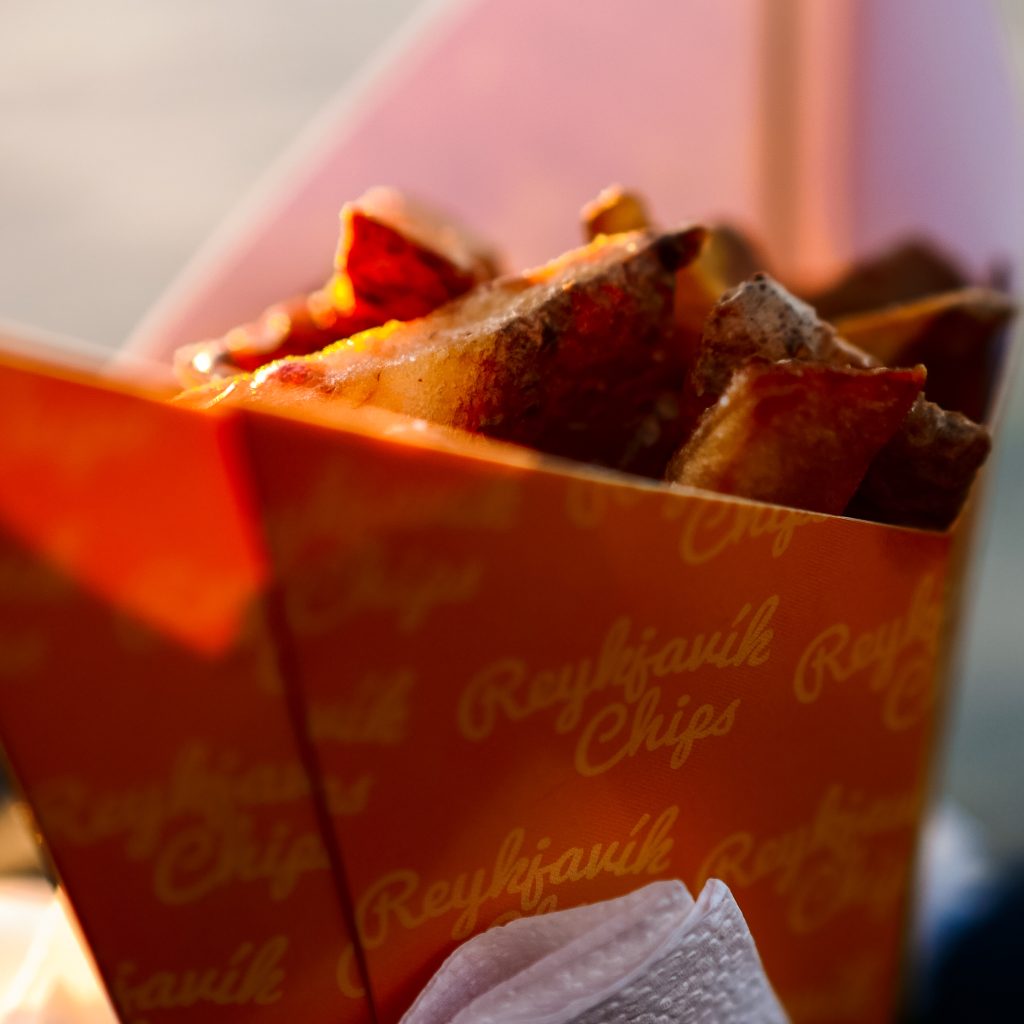
My diet has been fairly inconsistent while I have been on the road. I try my best to stay healthy but it is hard when you are moving everyday. One morning you skip breakfast and the next you find yourself eating bad Mexican food at a truck stop. You get a nice salad that night but then the next day all you eat is granola. That is until your gig in Philadelphia and you are so hungry you buy a massive cheesesteak hoagie and devour it on the street. You enjoy every bite of it but then afterward your stomach is crying ‘ what are you doing to me!?’ So the next day you buy an avocado, a loaf of rye, a cucumber and some greens. That should keep me feeling good right?
Nevertheless, at 2:00 in the morning you stop to get gas in rural Tennessee. You see two corn dogs sitting on the warmer and plunge into a deep state of self loathing. You eat the corn dogs and enjoy every moment, but your stomach is so utterly terrified of what you are doing that it nearly regurgitates everything you just put in it.
You sit in the silence of the car and curse the fast food industry. These thoughts start to trigger some other questions in your mind. There are people in our country who eat this kind of food every day of their lives. You don’t get the nourishment you need from this kind of ‘food’. The next time you travel through the highways of America think a bit about the cycle of our globalized economy and how what a lot of people consider ‘food’ is not much more than heart disease wrapped in a to-go bag. The industries of production that rule our corporate plutocracy will happily feed the people ‘foods’ of such vile a nature that our body doesn’t even know how to digest it properly. It is yet another systemic atrocity fueled by the fire of capitalism. Nevertheless, I will tarry on this point no longer. This paradigm of our modern industrialized food network can lead to many avenues of discussion and debate. However, no matter the viewpoints of any individual, the question I would like to propose concerning this topic is paramount for the health and longevity of human beings. The overarching question is;
‘How does one stay healthy in such an unhealthy world?’
This question is so multifaceted and can be interpreted and answered in such a rich variety of ways that I would like to be a little more specific with my address. More acutely;
‘How does one stay healthy while traveling?’
We decided to include some of our favourite ways to help care for our bodies while travelling…

Nutrition Essentials for Being on The Road
Hi! I’m Dayna. I’m popping in on the latter half of this blog post to share my tried-and-true herbal first aid and nutrition essentials for being on the road. Both Alexander and I have had many episodes of planes, trains and automobiles in our lives. Since I began learning about herbs, I’ve always had some herbal support for on the road.
Lets talk about herbal essentials for keeping our bodies just feeling well during travel. Here is a non-exhaustive list of some of my travel essentials for keeping my body “regular” in an irregular environment:
- Trace mineral drops – Bottled water, tap water from all over… We don’t know what we are getting while out on the road and trace mineral drops are your friend!
- A bag of dried prunes – An age old method for an extremely common problem we all experience while traveling! A few prunes a day will keep your bowel movements regular! Stock up at the bulk store and keep them around 🙂
- Mineral food powder – Some kind of blend of powdered seaweed, nutritive herbs like nettles and raspberry leaves, nutritional yeast and good quality salt. This can be incorporated by sprinkling it on just about any food you’re eating, takeout or otherwise.
- Digestif tincture – Eating at hours outside of your routine, unfamiliar meals, the list goes on! A good digestive tincture will come in handy. Taking those bitters before meals is going to do a lot for us.
- Oatmeal – This seems a bit silly to put in here, but I couldn’t begin to count the amount of times that I’ve made oatmeal in a mason jar using hot water from a gas station. Personally, having a bag of oats at hand helps me have access to fiber and gives me a sense of control over my food intake. We’ve all been subject to having a sad handful of nuts and a chocolate bar from the gas station and calling it “breakfast”.
- Optional tea blends – Depending on the type of trip you’re going on and what kind of space you have, if you’re able to, bring some of your favourite teas. They simply bring a sense of comfort and familiarity. You may reach for that bedtime blend, or that bloat-reducing blend more than you think!
If you have the space, try to bring something that just helps you feel comfortable. Something that carries a sense of home. Often-times for me, it is a perfume roller. Just some familiar scents! Compact and simple, and very effective for when I need it to ground myself.
Travel First Aid kit
There is definitely a difference between a first aid kit for home and a first aid kit for travel. At home, with the luxury of space, one’s apothecary would be equipped for most anything. However, I do spend a lot of time on the road and I really love to travel light. Like, really really light. Having a compact first aid kit of multi-purpose items is key.
In my years of travel, my first aid kit has changed, expanded and contracted. It still is changing to this day based on which herbs and remedies work best for me at any given time, which season we are in, and so on.
That being said, Here is my Travel First Aid kit – all of which fits into a small makeup bag!
Firstly, I don’t carry medicinal teas for “treating”. They are subject to losing potency, getting wet and perishing and most of all, they are bulky. If I wished to treat anything fully, rather than just having one cup, I wouldn’t have the space to carry the amount of tea required. For this reason, I stick to tinctures for emergency situations.
- Propolis tincture – For a variety of ailments, specifically treatment of upper respiratory infection, immune function, and to use topically to prevent the infection of and to mend wounds. Propolis is a great “all in one” sort of tincture to have!
- Some sort of Sleep Tincture blend – For both restless nights and moments of anxiety. It surprises me how often I use this, and how often others need it, too. It’s very useful. I find myself offering this tincture to friends often, and it helps. When we are traveling, we are sleeping somewhere new every night, and having some herbal support can be effective to get our bodies to actually rest even though we are in a new and changing environment.
- Throat spray of Sage, Marshmallow, Echinacea and Propolis tinctures, with honey in a spray bottle – Extremely useful active responders to upper respiratory infections and symptoms of hayfever, etc. If traveling in dry climates, this is great to keep on your bedside to hydrate your throat in the night when those dry coughs are keeping you up.
- Pain management Tincture of Willow Bark or California Poppy Tincture -Though, the latter has come in handy for both pain and anxiety and I find myself using it more often. Willow Bark I find more effective during a headache, and if I had the choice I would bring both.
- Kloss’ Liniment – A plethora of topical uses. A little goes a long way. I’ve used this for an endless amount of situations and now that I have, I wouldn’t be without it. For travel, I keep a 2 ounce bottle of liniment with a dropper top for easy use.
- An all purpose salve – For dry skin, mending wounds, lip balm, stings, etc. The blend of salve that I travel with changes depending on what I have available. A home-made blend of something like Calendula, Comfrey, Arnica, Plantain, Chaparral, and St. John’s wort would be ideal. However, If I don’t have access to making such things, and there isn’t anything like it made by a local herbalist, I find myself reaching for the “Super Salve” original salve with the green label. It’s a great blend and I can usually find it at any health food store.
- Sore muscle/bruising salve – I think it best to have a separate salve for this, if I have the space to carry it. A potent Arnica/Comfrey/St John’s Wort blend is great. In a pinch, Super Salve makes a good Arnica muscle balm that is also at most health food stores. It’s good to find brands that work for you that you can rely on when you don’t have your homemade medicines with you!
- French Green Clay – I’ve used this for relieving pressure headaches, and as a drawing poultice. It does wonders for relieving discomfort from bug bites/stings. Lots to be said about its digestive support in an emergency of the stomach. Sometimes it just makes a nice rejuvenating face mask for tired skin. It travels well and I find myself reaching for it more often than I think I will.
- Yarrow Powder – for stopping bleeding. I’ve used this in-action before and it worked extremely well. I always keep it on me. Cayenne does the same thing, and is also a helpful ally during a bout of the flu or a cold, among its stimulating effects. Perhaps I could keep some of that around, too.
- Gauze or Cheesecloth – for making poultices, dressing wounds, creating an emergency sling, for making bandages.
- A needle and thread – Wishing that I wouldn’t have to give myself or someone else stitches, and that a hospital would be near in such a situation. But in the case that one would not be close, it would be best to have a needle and thread rather than not. And in any case, I’ve always got endless clothes to mend and buttons to replace either way.
If I have ample space, I’ll also bring..
- A hot water bottle – I often use it for menstrual cramps, but it has come in handy for many other situations in which sustained heat is needed.
- Emergen-C powder – A real game changer in moments of dehydration, and during the winter months.
- Thieves Essential Oil Blend – I don’t use essential oils often, but I do find this blend very helpful. It comes in handy for a lot of things, specifically disinfecting. I love to add a few drops to a bowl of soapy water when I am cleaning surfaces/floors. I cured myself of a bad sinus infection with a few drops of thieves oil in face steams once when it was the only thing I had with me.
Photos provided by Serena Mor
Coffee: The Good the Bad and the Ugly
An Historic Global Enterprise
Coffee is one of the most ubiquitous and widely consumed beverages in the world, second only to water. The already extraordinary demand for coffee only seems to be increasing; global coffee production reached 175.35 million 60-kilogram bags as of 2020/2021, increasing from about 165 million 60-kilogram bags in 2019/2020.
Coffee drinking, and the knowledge of the coffee tree as a medicinal substance, dates back to at least the mid 15th century, where we find our first credible historical evidence pertaining to its use in the accounts of Yemini author Ahmed al-Ghaffar. The coffee tree was most likely introduced into Yemen by way of trade routes with Ethiopia from across the Red Sea. Thus, given that the coffee tree was being traded and exported from Africa, it is highly unlikely that its medicinal, recreational, and social values were only realized in the 15th century, in a country where the tree itself was not native. The use of coffee almost certainly reaches back much further than the 15th century, though specifics concerning its initial discovery by the peoples of the African continent and its use in their traditional systems of medicine and culture remain obscure.
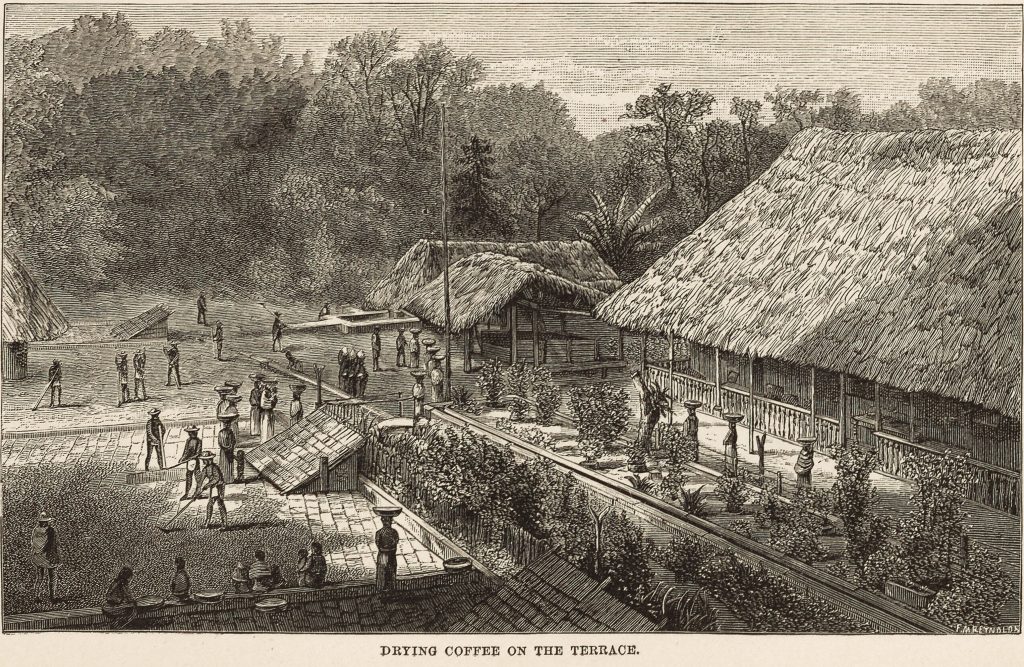
When it comes to the earliest detailed historical records concerning the use of coffee, we can look to the work of Harvard historian Cemal Kafadar, where it is revealed that the social significance of coffee in Islamic society was established by way of its use in Sufi religious rituals:
“To turn to the early history of coffee and coffeehouses, more specifically, there must have been many instances when coffee was consumed as a plant found in the natural environment of Ethiopia and Yemen, but the earliest users who regularized its consumption as a social beverage, to the best of our knowledge, were Sufis in Yemen at the turn of the fifteenth century. Evidently, they discovered that coffee gave them a certain nimbleness of the mind, which they were keen on cultivating during their night-time vigils and symposia. Thus started the long history of the appreciation of coffee as a companion to mental exercise and conviviality, particularly when one wished to stretch or manipulate the biological and social clock.”1
The Start of The Coffee House Phenomenon
It is from this point onward that coffee houses started to appear across Arabia and gradually, over the next three centuries, throughout the rest of the world. The historical significance of the coffee house is inextricably bound up with the historical significance of coffee itself; the coffee house has always served as a kind of public institution and cultural hub through which all manner of information – from the common and mundane to the revolutionary and political – was shared and disseminated amongst the population. Even today, in a world increasingly characterized by digital identities and disembodied forms of social engagement, the coffee house still serves as a place of respite, where people can turn for a semblance of embodied interpersonal interaction and exchange in an evermore alienating and depersonalizing world.
Coffee’s appearance in Europe (especially England and Germany) in the late 17th century coincided with the discovery that clocks could be controlled by harmonic oscillators. This was followed in the 18th century by a series of technological discoveries and breakthrough inventions that lead to increasingly precise clocks, and hence to a heretofore unimaginable regimentation of time itself. Is it a mere coincidence that coffee – utilized by so many for the purposes of maintaining attention and increasing stamina – came to Europe just as machine production and the Industrial Revolution, with the inhuman demands it placed on workers, led to a decline in hand production and the artisanal trades of the past? From the perspective of cultural history, coffee has a dual identity; as a tool for social conviviality and the free flow and exchange of ideas (exemplified by the institution of the coffee house), as well as a crucial ingredient in the engineering of the industrial worker, allowing for the kind of over-stimulation that is required to meet the demands of the fast paced, mechanized world of industrial society. The hegemony of standardized clock time, and the counting of seconds, minutes and hours as measures of productivity and profitability, violated the natural diurnal rhythms that human beings had always used to orient their lives. The question remains as to the extent to which coffee played a role in one of the biggest cultural shifts in recorded history.
Historical Religion and Politics
The opinion of the medical profession with respect to coffee has been divided throughout history. Coffee is exemplary when it comes to demonstrating the degree to which medical opinion can be deeply influenced and shaped by cultural and political trends and assumptions. Indeed, the medical, socio-political and religious views of coffee were at times inextricably bound up with each other, making it next to impossible to disentangle one from the other. Where does religious belief end and medical “fact” begin? We can explore this issue by taking a closer at the early history of coffee in the Islamic world, and the changing tide of opinion with respect to the most influential and powerful drink in the world, next to water itself.
In contrast to the view that the introduction of coffee into liturgical practice was a great blessing in that it allowed worshipers to better execute their devotions to God, other religious scholars argued that coffee should be outlawed insofar as it had never been mentioned in the Quran. Many of these scholars were also concerned about what they perceived to be the deleterious health consequences of coffee consumption. But this controversy is even further muddied when we stop to consider the political climate of the time. While some commentators argue that the various attempts to outlaw coffee in the Islamic world were a consequence of religious and medical opinion, the truth is more likely that coffee (and the social revolution spurred by the birth of the coffee house) was perceived as a political threat.
“Between the early 16th and late 18th centuries, a host of religious influencers and secular leaders, many but hardly all in the Ottoman Empire, took a crack at suppressing the black brew. Few of them did so because they thought coffee’s mild mind-altering effects meant it was an objectionable narcotic (a common assumption). Instead most, including Murad IV [the Ottoman sultan who issued a ban on coffee in 1633], seemed to believe that coffee shops could erode social norms, encourage dangerous thoughts or speech, and even directly foment seditious plots.”2
In what is perhaps an unexpected twist, our brief survey of the cultural and political history of coffee has revealed the extent to which many of our deeply held assumptions, sometimes taken as objective fact, in actuality rest upon a socio-political and theological underpinning of opinion and currents of dogmatic belief which colour our perception, of which we may be mostly or even totally oblivious.
PART II: Coffee as Medicine, Coffee as Poison
What is the difference between a food and a medicine? In his essay from 1803 titled ‘On the Effects of Coffee’, Samuel Hahnemann (the founder of homeopathy) set out to clarify this distinction and to warn of the deleterious effects of the unchecked consumption of medicinal substances, taking coffee as a paradigmatic example. Hahnemann writes:
“Medicinal things are substances that do not nourish, but alter the healthy condition of the body; any alteration, however, in the healthy state of the body constitutes a kind of abnormal, morbid condition. Coffee is a purely medicinal substance. All medicines have, in strong doses, a noxious action on the sensations of the healthy individual. No one ever smoked tobacco for the first time in his life without disgust; no healthy person ever drank unsugared black coffee for the first time in his life with gusto — a hint given by nature to shun the first occasion for transgressing the laws of health, and not to trample so frivolously under our feet the warning instinct implanted in us for the preservation of our life.”3
A medicine is a substance that serves to alter the state of health, whereas a food is a substance that serves to provide nourishment. When medicines are taken in excess, or when they are not properly indicated for an individual person, they can produce an abnormal or even pathological condition. Medicines can preserve life and maintain health, though they can also derange the state of health and take life away when they are given without the requisite attention or care. Food substances can likewise produce states of disease if they are eaten to excess, though the deleterious effects of foods generally take a much longer time to manifest when compared to the stronger power of medicinal substances to affect deep seated changes on the level of constitutional vitality.
While in 1803 Hahnemann condemned the use of coffee, going to so far as to argue that its unchecked consumption was the origin of many of the chronic diseases that plagued humanity, he later toned down his opinion, having developed a much more sophisticated theory of the origins of chronic diseases by way of the concept of the miasms (the 18th century precursor to our contemporary theories of epigenetics, and one of the philosophical foundations of homeopathic medical practice to this day). Nevertheless, Hahnemann was right to emphasize the extent to which medicinal substances, when treated as foods and consumed injudiciously, can exert profound effects on the state of health. This is especially true if conditions of heightened susceptibility to a given substance are at play in an individual’s constitution (think here of the example of severe allergic reactions to substances that to most people are extremely benign). Human response to coffee and to caffeine varies widely, and like any assessment of a medicinal substance, individual response patterns must always be given a higher regard than overly generalized, universal theories and pronouncements. The difference between a medicine and a poison is ultimately in the dose, and the effect of the dose is always weighed in relation to the individual to whom it is administered.
The Hahnemann of 1803 represents one extreme when it comes to thinking about coffee as medicine. A look at the medical literature on coffee, from from the 15th century to the present day, is full of contradictory and opposing points of view. Coffee was for centuries listed in the pharmacological and medical literature that herbal and Eclectic physicians relied upon, such as the Codex Medicus. Coffee remained classified as a medicinal substance in materia medica and pharmacopoeias until the twentieth century, when the use of natural medicinal substances was largely supplanted by the products of the petrochemical drug industry. Maria Letícia Galluzzi Bizzo et al. recount some of the claims made about coffee in the medical traditions of the West, emphasizing and siding with the view of coffee as a universal elixir of health (the poplar opposite of Hahnemann’s position):
“As a panacea, coffee has been prescribed as infusions, capsules, potions, or injections against a vast spectrum of diseases— from hernias to rheumatism, from colds to bronchitis. In the first half of the nineteenth century, medical controversies underlined the therapeutic use of caffeine in chronic conditions such as heart and circulation problems because of difficulties establishing the proper doses and the risk of toxicity to the heart. Nevertheless, the notion that such use would be safe prevailed. Recent research has opened new horizons regarding the use of coffee as a medicine, with discoveries of possible distinct preventive and curative applications of coffee’s substances.”4
The Coffee of Today
The medical opinions of the past are in many ways inadequate when it comes to judging the effects of coffee today. The coffee of the 1800s is not the coffee of the 21st century. Consider, for example, the question of pesticides. Only about 3% of the world’s coffee supply today is produced using organic methods, and we now know that the residues of pesticides found on coffee beans, one of the most pesticide ridden agricultural products in the world, are for the most part not destroyed by the roasting process. Many countries that produce coffee use pesticides that have been banned in North America and Europe over health and safety concerns, and a significant number of the countries which import this coffee do not have maximum residue limits (MRLs) when it comes to the pesticides that are used and can be detected on the harvested coffee beans.

Mold is yet another issue. When not stored in a temperature controlled storage facility, coffee beans are also highly susceptible to developing mold, which comes with its own host of long term adverse health effects. Even roasting techniques have a great bearing on coffee’s potential effects on one’s state of health. One study carried out by the International Association for Food Protection, for example, comes to the following ambiguous conclusion concerning the question of the carcinogenicity of coffee and how this is affected by the roasting process:
“Roasting coffee results in not only the creation of carcinogens such as acrylamide, furan, and poly-cyclic aromatic hydrocarbons but also the elimination of carcinogens in raw coffee beans, such as endotoxins, preservatives, or pesticides, by burning off. However, it has not been determined whether the concentrations of these carcinogens are sufficient to make either light or dark roast coffee more carcinogenic in a living organism.”5
There are a whole host of other socio-economic and political considerations that should be borne in mind with respect to the global coffee industry of the 21st century. Health is not a purely individual consideration; the health of your body and mind are indissociably bound up with the functioning of the larger natural and artificial systems in which you exist. We are unwitting participants in a global system of capitalist exploitation which, through the untiring impulses of profitability and expansion, inevitably leads towards the total degeneration of the natural world and the complete immiseration of its inhabitants. A sober and careful look at coffee and its economic, political, and agricultural ramifications, inevitably alerts us to a confrontation with this reality.
Capitalism, Globalization, and the Politics of Coffee Production:
The pesticide residues found in your average bag of coffee are inconsequential in comparison to the toxicity that third world coffee farmers are exposed to on a daily basis. These farmers, in addition to the dire health consequences of chronic chemical exposure that are an unavoidable part of their work, lead lives that are dictated by the brutal conditions of strenuous labour, physical exploitation and the inter-generational cycles of inescapable poverty, child labour and indentured servitude. Alice Nguyen, in an article written for The Borgen Project (a non-profit organization dedicated to addressing the global issues of poverty and hunger), unflinchingly encapsulates these issues:
“Growing coffee requires intensive manual work such as picking, sorting, pruning, weeding, spraying, fertilizing and transporting products. Plantation workers often toil under intense heat for up to 10 hours a day, and many face debt bondage and serious health risks due to exposure to dangerous agrochemicals. In Guatemala, coffee pickers often receive a daily quota of 45 kilograms just to earn the minimum wage: $3 a day. To meet this minimum demand, parents often pull their children out of school to work with them. This pattern of behavior jeopardizes children’s health and education in underdeveloped rural areas, where they already experience significant barriers and setbacks.”6
Facts like these seem to underlie the importance of Fairtrade and Organic Certification for coffee and related products, which in principle strive to ensure sustainable development, equitable trading conditions, and giving autonomy back to marginalized farmers and agricultural workers. However, consumers in the Western world must not fall into the self-congratulatory trap of thinking themselves morally superior because they are able to afford the often vastly more expensive Organic and Fairtrade Certified products that are simply outside of the economic reach of many. The reality is that, in many instances, the increased profits from organically grown coffee products do not reach the farmers and laborers themselves, but end up lining the pockets of the distributors, who in many regions of the world function in similar ways as do drug cartels.
What is more, there are the significant and rarely discussed pitfalls of introducing organic agricultural techniques to farmers who work on lands that have been treated with chemical pesticides for decades. Such agricultural land will require significant time and effort in order to be rehabilitated such that organic farming can be sustained there. This means that farmers who are already struggling to maintain their operations run the risk of falling even further into economic enslavement if they are coerced into adopting the organic methods that righteous and ecologically minded politicians, consumers, academics and other self proclaimed “experts” in the Western world preach about with moral fervour.
Consider the following story, told by the son of a soybean farmer working in El Toledo, Costa Rica. He recalls a childhood memory of the year his father was convinced by Penn State University professors to adopt organic agricultural techniques, under the promise of increased profitability and the ecological restoration of their farmland:
“The professors convinced my dad to make a wholesale change from conventional soybean farming to organic. They warned him that he might lose up to 15% of his yield, but that this would be offset by a number of factors: He could sell his soybeans for more, as they were organic. His soil would be healthier. He would spend less on chemical inputs, and thus save money. The reality was very different. Instead of losing 15% of our yield, we lost 50%. Instead of spending less money, he spent more: the gas he spent to tractor over the weeds alone outstripped his usual chemical spending.
He ended up taking a job in a factory to avoid bankruptcy. All I remember is that when I was eight, I never saw my dad: he was either weeding the soybeans or at the factory. As soon as that season ended, we went back to chemical farming.”7
Many such stories, pertaining to all manner of farming from all parts of the world, can be found if one cares to look beyond the ‘Certified Organic’ and ‘Fairtrade’ labels that one sees plastered on one’s favourite products lining the local supermarket shelves. From coffee and soybeans to chocolate and Brazil nuts and beyond, the exploitation of labourers and the degeneration of the world’s ecosystems are part and parcel of our contemporary agricultural systems of production, whether conventional or organic. Any consideration of “sustainability” must always be understood within the framework of the global capitalist economic system in which we exist. As the political and cultural theorist Mark Fisher so poignantly put it in his book Capitalist Realism: Is There No Alternative?:
“The relationship between capitalism and eco-disaster is neither coincidental nor accidental: capital’s ‘need of a constantly expanding market’, its ‘growth fetish’, mean that capitalism is by its very nature opposed to any notion of sustainability.”8
The preceding section of this article is not intended to inculcate feelings of guilt, a sentiment which only leads to a place of demoralization and further defeat. Rather, it was written out of an honest assessment of the situation in which we all find ourselves as consumers in a system which, in its vast complexity, far transcends the individual decisions that you and I make on a daily basis. It is only from a place of sober awareness that a genuine desire for a better world can be nurtured and allowed to bear fruit.
And now, with these economic, cultural and political factors in mind, let us turn to consider the detailed effects of coffee from a more purely medical perspective. A well rounded discussion of coffee requires that we adopt a multi-perspective view. Single vision is, after all, what the capitalist system of exploitation itself is based on.

PART III: Coffee’s Medicinal Effects: What Can Reliably Be Said?
Coffee is a nervine stimulant, i.e. an herb that causes excitation and stimulation of the nervous system, specifically by engaging or heightening the activity of the sympathetic nervous system. The most widely known and discussed function of the sympathetic nervous system is the mediation of the neuronal and hormonal stress response pattern known as the fight-or-flight response. The sympathetic nervous system is what allows the body to quickly react and respond to situations of threat and danger, to situations that threaten survival. But the sympathetic nervous system cannot be adequately understood if we look at it as an isolated regulatory or physiological function. The sympathetic nervous system works in concert with the parasympathetic nervous system and together make up what is called the autonomic nervous system. The autonomic nervous system regulates and controls many of the functions of the body’s internal organs. When we consider the interdependence and co-functioning of the sympathetic and parasympathetic nervous systems, then we can begin to understand that the stress response typically associated with the sympathetic nervous system is one pole or extreme of a greater homeostatic controlling mechanism which oversees the feeling and function of the human organism on many levels.
However, excessive stimulation of the sympathetic nervous system can and does result in undue consequences. Herbalist David Hoffmann explains the action of nervine stimulant herbs, and relates their functions to the excessively heightened states of excitation that characterize the frantic and overwrought patterns of 21st century existence:
“Direct stimulation of nervous tissue is not often needed in our hyperactive modern lives. In most cases, it is more appropriate to stimulate the body’s innate vitality with the help of nervine or bitter tonics. These herbs work to augment bodily harmony, and thus have a much deeper and longer-lasting effect than nervine stimulants. In the 19th century, herbalists placed much more emphasis upon stimulant herbs. It is, perhaps, a sign of our times that the world now supplies us with more than enough stimulation. When direct nervine stimulation is indicated, the best herb to use is Cola acuminata, although Paidlinia cupana, Coffea arahica, Ilex paraguayensis, and Camellia sinensis may also be used. One problem with these commonly used stimulants is their side effects; they are themselves implicated in the development of certain minor psychological problems, such as anxiety and tension. Some of the volatile oil-rich herbs are also valuable stimulants. Some of the best and most common are Rosmarinus officinalis and Mentha piperita.”9
Caffeine is the most widely recognized and studied active ingredient in coffee as well as many other stimulant herbs (such as those listed in the above quotation). But coffee also contains a wide array of other important constituents such as tannins, fixed oils, carbohydrates, and proteins, which should not be forgotten, as coffee, just like all herbs, are irreducible to their component parts. It is through the roasting process that caffeine is liberated from the raw coffee bean. Caffeine produces diuretic and stimulant effects, specifically on the respiratory, cardiovascular and central nervous systems.10 Caffeine is also an analgesic adjuvant, and hence is incorporated into a wide number of proprietary aspirin and acetaminophen preparations.11 Coffee also contains phytoestrogens, which have been subject of a great deal of scientific debate. Phytoestrogens can play a role in addressing symptoms and conditions caused by estrogen deficiency, which may be especially pronounced in premenopausal and post-menopausal women. They are also implicated in memory and learning processes and have been shown to possess anxiolytic effects. The research into the effects of phytoestrogens on human health is still ongoing, and is a fruitful and fascinating area of research. For example, consider the fact that the consumption of beer, bourbon, mescaline, cannabis, and coffee all produce phytoestrogenic effects – the relationship between psychoactivity and phytoestrogenic compounds certainly needs to be more deeply explored!
When it comes to consider possible contraindications and adverse reactions from coffee consumption, we should note that coffee, along with fried and fatty foods, chocolate and alcoholic beverages, can lead to or serve to aggravate LES dysfunction (the lower esophageal sphincter, which links the esophagus and the stomach). Obesity, pregnancy, cigarette smoking, and a structural weakness of the diaphragm known as hiatus hernia can also contribute to a weakening of the LES. If the LES fails to properly close, stomach acid can easily splash up from the stomach into the esophagus, leading to severe acid reflux and heartburn. Gastroesophageal reflux disease (commonly known by the acronym GERD) is associated with a leaking of stomach contents back into the esophagus. When there is a prolonged period of LES dysfunction, this can lead to acid and chemical damage of the esophagus, that is, to GERD.
The consumption of coffee and other caffeine containing substances can also result in headaches. The headaches that are associated with coffee consumption are often related to caffeine dependence, which can lead to significant withdrawal symptoms in some individuals. As Hoffmann writes:
“Caffeine can cause headaches by increasing the body’s expectation for it. When blood levels of caffeine drop, symptoms of withdrawal, including headache, may set in. That’s why some heavy coffee drinkers experience “morning headache” until they have that first cup of coffee. Caffeine headaches are usually experienced as a dull, throbbing pain on both sides of the head. Once the body rids itself of caffeine, the headaches disappear on their own. Such headache sufferers, however, are often unaware that their problem is due to caffeine and will continue to drink coffee, ensuring that the problem will recur.”12
We can look to the homeopathic literature to round out our consideration of the spectrum of effects that coffee can have. In homeopathy, the medicinal effects of a given substance are elaborated through clinical experience as well as through provings. A proving entails rigorous and detailed observation of the effects of a substance when administered at a sufficient dosage in its crude form and/or as a dynamic or potentized medicine (having been subjected to serial dilution and succussion or vigorous shaking), such that it produces modifications to the state of a person’s health and disposition. The fundamental principle of homeopathic prescribing is that like treats like. In other words, if a substance can cause a certain symptom on the physical, mental/emotional, or dispositional level in a relatively healthy person, then it can in like manner work to treat those same symptoms when they are expressed by a patient who comes seeking care.
Dutch Homeopath Jan Scholten describes the essence of the patient needing potentized coffee (Coffea Arabica) in the following way:
“Coffea is the ideal intellectual worker. They feel stable, focused and self-confident in their mind… They are independent and responsible, following their own plans.”13
The coffea patient often possess a great deal of stability, they are responsible, hard working, persevering, and their actions are well organized and carefully planned. Coffee in its crude form can serve to promote these qualities in people, so it is no wonder that many rely upon it in a culture which emphasizes work, productivity, and efficiency. Scholten explains that the mind of the coffea patient can be active and full of ideas. They can have clear, active, and lucid thoughts, are fast and easy learners with great comprehension skills. They can experience a rush of thoughts, a heightened sense of judgment and sharp and acute states attention. They tend to be quite ambitious people, with a strong and even overpowering need to achieve. They can feel that they must work as hard as possible to fulfill their own expectations, as well as the expectations of their parents (especially the father). Given the great demands that they place upon themselves, and the seriousness with which they approach their assigned tasks and responsibilities, the coffea patient can experience states of pronounced nervous agitation, excitement, exaltation, hilarity, restlessness and irritability – think of the states associated with and over-excitation of the nervous system.
Oversensitiveness is a keynote of this remedy, and all of the senses – sight, hearing, smell, taste, and touch – can be greatly heightened. Eating and drinking are things that they do quickly and in a hurried way, as befits their general tendency towards restlessness, hurry, and hyperactivity. The coffea patient may also be the type of person who feels that they cannot live up to the pronounced and unrelenting demands and expectations that they are faced with, and hence suffer from a lack of self confidence, which is improved through the use of stimulants. They feel things intensely, and can have a tendency to exaggerate their emotions and be highly susceptible to the impressions to which they are exposed. Emotional excesses, from extraordinary states of pleasure, optimism, and joy (coffea is a remedy for ailments from excessive joy) to the polar opposite of pronounced despair and despondency, with sharp anger and rudeness. When in this latter state, they can throw everything away, disposing of all that they have been given – in contrast, they can also be excessively clingy, and want to desperately hold on to people and their possessions. They feel pain intensely, and their anguish can run deep. Coffea can have the following delusions: “paradise, magnificent grandeur, beautiful world, heavenly scenes.” They experience states of benevolence and idealism, with a desire to perform good deeds, and veneration for the Supreme Being. Coffea may be prescribed for “ailments from vexation, mortification, frustration; discords between relatives, friends; hurry; anticipation; sudden emotions, pleasurable surprises.” The treatment of a variety of headaches, neuralgic pains and spasmodic afflictions, heart palpitations, digestive disturbances, and states of insomnia may also be addressed with coffea.
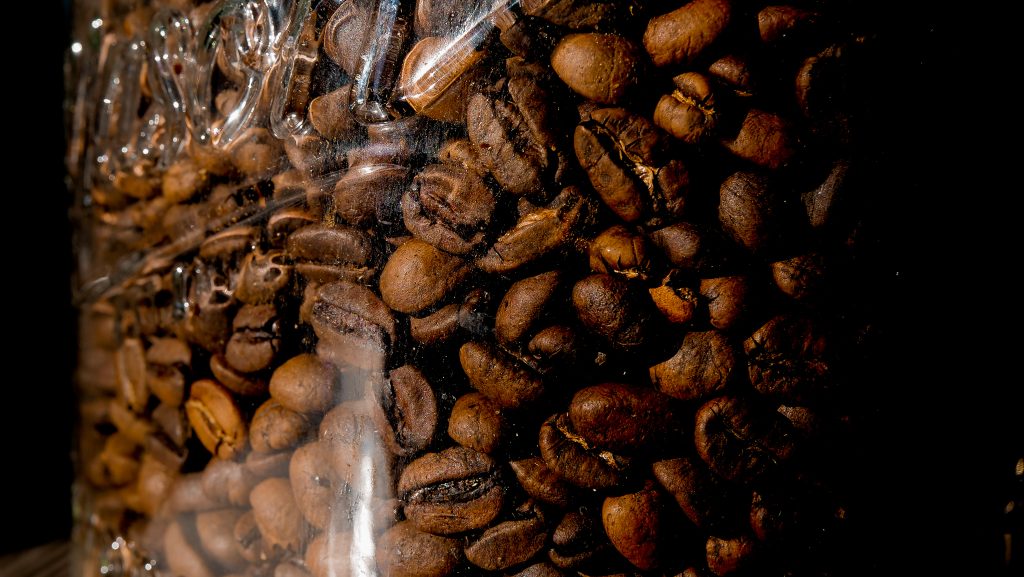
In Conclusion…
From our explorations into all things coffee, we may conclude that it is, perhaps more than any other substance in existence, paradigmatic of the culture of modernity. From controversies regarding altered states of consciousness to the regimentation of life brought about through the reign of clock time, from the exploitation of agricultural workers in the 3rd world to meet the needs of the Western consumer to controversies in the medical profession concerning the difference between medicinal and poisonous substances, coffee is both practically and symbolically encoded with many of the most pressing concerns of the culture of modernity. Our investigations into coffee have served to reveal the myriad ways in which everyday substances are always already embedded within and serve to reflect the complex cultural, economic, and political realities in which we exist. The tremendous extent to which plants play a role in shaping human culture through modification of the patterns of human thought and behaviour has also become clear. We have long ago reached the point that our world would be unrecognizable without coffee.
Footnotes:
1 Cemal Kafadar. ‘How Dark is the History of the Night, How Black the Story of Coffee, How Bitter the Tale of Love: The Changing Measure of Leisure and Pleasure in Early Modern Istanbul’ in Medieval and Early Modern Performance in the Eastern Mediterranean, ed. by Arzu Öztürkmenand Evelyn Birge Vitz, lmems 20 (Turnhout: Brepols, 2014).
2Mark Hay. ‘In Istanbul, Drinking Coffee in Public Was Once Punishable by Death.’Atlas Obscura, May 22, 2018. https://www.atlasobscura.com/articles/was-coffee-ever-illegal
3 Samuel Hahnemann, The Lesser Writings Of Samuel Hahnemann, ed. and trans. R.E. Dudgeon. New York: William Radde, 1852. Pg. 392.
4 Maria Letícia Galluzzi Bizzo et al. ‘Highlights in the History of Coffee Science Related to Health.’ Science Direct, 7 November 2014. https://www.sciencedirect.com/science/article/pii/B9780124095175000024
5 Joseph Kim et al. ‘Safest Roasting Times of Coffee To Reduce Carcinogenicity.’ PubMed, 1 June 2022. https://pubmed.ncbi.nlm.nih.gov/35226750/#:~:text=Abstract,or%20pesticides%2C%20by%20burning%20off.
6 Alice Nguyen. ‘Bitter Origins: Labor Exploitation in Coffee Production.’ Borgen Project, 24 September, 2020. https://borgenproject.org/labor-exploitation-in-coffee-production/
7 Brian Stoffel. ‘Urban Elites, Organic Farming & The Hypocrisy of No Skin-In-The-Game’. 14 June, 2017.
https://medium.com/@stoffel.brian/urban-elites-organic-farming-the-hypocrisy-of-no-skin-in-the-game-b9f95b655686
8 Mark Fisher. Capitalist Realism: Is There No Alternative? Oregon: Zero Books,2009. Pg. 18-19.
9 David Hoffmann. Medical Herbalism. Vermont: Healing Art Press, 2003. Pg. 519.
10 Ibid, pg. 124.
11 Ibid.
12 Ibid, pg. 365.
13 Jan Scholten. ‘Coffea Arabica.’ QJURE (undated publication). https://qjure.com/remedy/coffea-arabica-2/
Illustrations/Images:
- Illustration: Novel “Coffee: From Plantation to Cup. A Brief History of Coffee Production and Consumption” 1881 [x]
- Photos provided by Serena Mor
Old Fence Rows and Buckthorn
Spring is Ever Drawing Nearer
My fingers are itching to be in the earth once more – to sow and plant — bringing me into a deeper connection with the Earth once more. Our seeds have all been delivered and our trees ordered, and we are already busy here on the farm. The sugar shack is getting a new wind break and the chainsaw is sharpened and ready to go. With the snows melted and frost still in the ground it is the perfect time of year to work away at controlling the invasive Buckthorn.
As many of you know, besides being a clinical herbalist, educator and tea blender extraordinaire (a tea nut to some), we are a botanical sanctuary member of United Plant Savers. Gifting back to the Earth, thankful for all she has gifted us, especially plant medicine. So, we have been busy planting and rewilding for over thirty years now. Our goal is to plant as many endangered and native medicinal plants and trees as we can each spring and fall.
Over the years, we have had a few comments about the non-native species growing and thriving on the farm, people encouraging me to consider digging them all out, eradicate the invasive species from the land.
(Invasive species: “An organism that is not indigenous, or native, to a particular area.”)
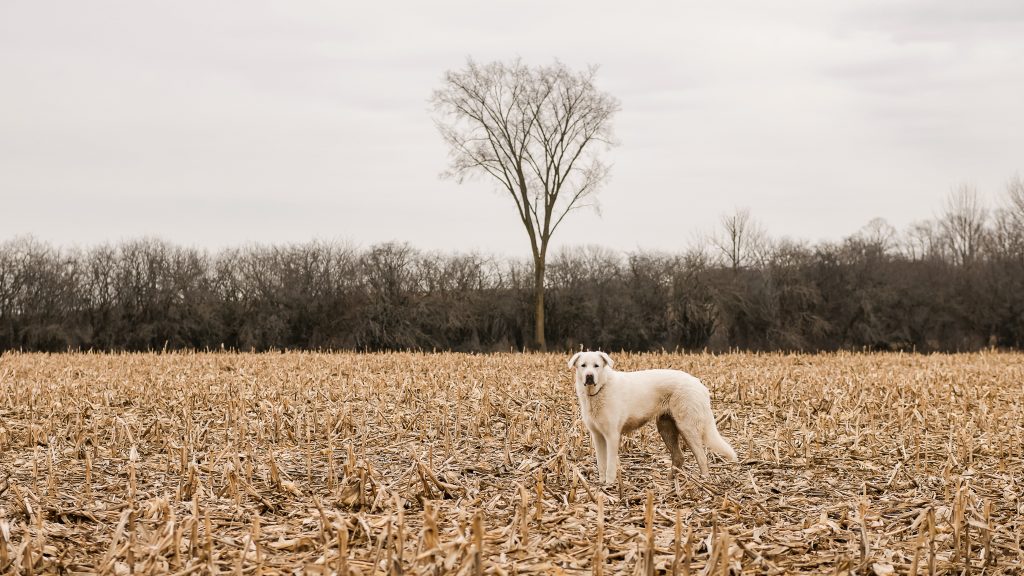
This is easy to say for a person who is not doing the ‘work’ or not possessing a strong love for all who grow and live on these one hundred acres of land. Do we cut down non-native trees, who’s limbs hold nests of baby birds? Do I pluck every Plantain plant from the land? Do we dig up the lilacs brought with the pioneers, that still grace this farmstead — reminders of days gone by? What about her fragrant blossoms that the pollinators seek out each spring? Think about the connection they have already formed to this land.
What about the invasive species that take over an area and swallow up what was there before? These I am trying my best to keep in check and harvest freely for medicine — Phragmites and Garlic Mustard, recently appearing. But Buckthorn is a different story – she has literally kept me awake at night – how do I handle this undesirable invasive small tree?
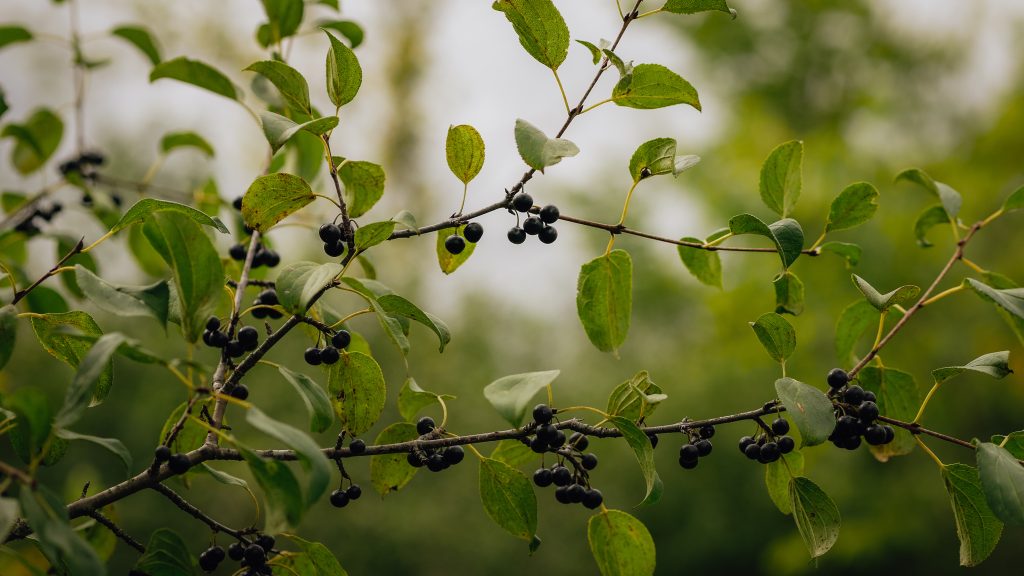
Description of Buckthorn:
Buckthorn’s main stem is erect, with bark smooth, of a blackish-brown colour, on the twigs ash-coloured. The smaller branches generally terminate in a stout thorn, giving it the name Buckthorn. There are many older names by which this shrub has been known: Waythorn and Highwaythorn. The leaves grow in small bunches, mostly opposite. They are egg-shaped and toothed on the edges, small greenish-yellow flowers are produced, which are followed by globular berries about the size of a pea, black and shining when ripe, and each containing four hard, dark-brown seeds.
Medicinal Action and Uses of Buckthorn
Laxative and cathartic.
The berries are used medicinally, collected when ripe and made into a syrup of Buckthorn, which was used as an aperient drink.
Until late in the nineteenth century, syrup of Buckthorn was a most favourite remedy, used as a children’s laxative, but its action was so severe that, as time went on, the medicine was discarded. It is now used almost exclusively in veterinary practice only, being commonly prescribed for dogs, with equal parts of castor oil as an occasional purgative.
Nature’s Wildlife Highway
Buckthorn was brought here with the European settlers as an ornamental bush and to line fencerows. Keeping livestock in and to serve as much needed windbreaks for the newly cleared land. Some people may only see Buckthorn when they look at these old hedgerows, but there, amongst their midst, if you look much deeper you will see the Birch, Wild Apple trees, Maples, Mountain Ash, Basswood, Aspen, Puff balls, Morels and blankets of our beloved woodland flower, the Trout Lily – which takes over seven years to receive her first bloom!
The hedgerows on our farm are over one hundred and twenty-five years old, deep within the bushes and trees are the remains of old rotting cedar zig zag rail fences, that once marked the property boundaries. These rails now offering homes for small critters and insects, slowly decomposing and feeding the soil, and nurturing the surrounding plant life. These fencerows provide wildlife with shelter and food, and well used trails for safe travel. Connecting the travelers to other fence rows and more trails. We can’t forget the help these hedgerows gift our pollinators as well, with over thirty Wild Apple Trees — all a blossom in the spring and a buzz with life. Providing rich pollen and nectar that our bees use for nutritious food and to make their honey. Many of these old fencerows are being cleared on neighbouring farms. Cleared for more workable land and giving the huge farm equipment of today more room to maneuver with ease. Saving the farmer’s valuable time, but at what cost to our wildlife?
Do I dare disturb this delicate ecosystem? Do I disturb the hidden trails within – taking the safety from the Deer, Coyote, Fox, Wild Turkey, Lynx, Fisher, Bear, and many other creatures who frequent these paths. Buckthorn has been a crucial part of the hedgerow, nurturing the young trees and plants. With connections like these the decision is easy, my intuition has always known, the Buckthorn filled fencerows will NOT be disturbed in any way.
This is my heartfelt commitment to this land.
“Look deep into nature, and then you will understand everything better.”
~ Hans Christian Andersen
Photos Provided by Serena Mor
Arnica: Materia Medica
Arnica and its Application
Arnica is an herb with a “strange history”, as herbalist Rudolf Weiss comments,
“It used to be very popular, being used internally as well as externally. It is said that the German writer, poet and scientist Goethe would ask for Arnica tea when in his old age he experienced anginal pain due to coronary arteriosclerosis” (Weiss: 1994, 169).
In fact, Goethe claimed that Arnica had saved his life. He sang the praises of Arnica, holding it up as an archetypal healing herb with associations to Helios (the all-knowing God of the sun, of prophecy, and of healing) and Asclepias (son of Helios, the caduceus wielding God of medicine, healing, and rejuvenation who oversees physicians and the practice of the healing arts amongst human beings). Goethe writes:
“Thus I assign Arnica to Helios among the gods. And among men? To the follower of Asclepias who wanders among the lonely heights. Here we have a plant of rapid healing, of firm decision. If you suffer violence and injury, from fist, cudgel or blade, wondrous healing is nigh in this herb. The vital energies are flowing, the pulse grows stronger, the heart takes courage; if the blood has lost its way in a bruise or an effusion, arnica will remind it of its proper courses. Muscles and sinews grow firm; the body form, having suffered insult and injury, is restored, and so is the nervous system where it is so difficult to achieve healing. The organic revolt at injury sustained — we call it pain — lessens and passes.”1
Topical Verses Internal Use
Despite Goethe’s praises, most contemporary authors and practitioners of herbal medicine warn of the dangers of the internal use of Arnica, though it is still widely used topically. The chief indications for the topical use of Arnica include bruises which have resulted from a fall, a blow, or other accidents, as well as poorly healing wounds and leg ulcers.
Weiss notes a traditional use of Arnica tea or tincture (5-10 drops per cup of water) as a gargle to treat sore throat and pharyngitis. “This was found to be most effective with chronic conditions where the circulation was poor in the pharyngeal region, particularly chronic granular pharyngitis, and for chronic smoker’s cough, giving symptomatic relief” (Weiss: 1994, 170).
Arnica provides some of its greatest curative effects in patients who suffer from poor circulation, given its special affinity for the vascular system. In this respect, Arnica covers some of the same clinical indications as does Hawthorn, specifically “senile hearts and coronary artery disease with or without angina” (ibid). Both Arnica and Hawthorn serve to improve the blood supply through the vessels of the coronary artery, though Arnica exerts a pronounced stimulating action in this region and as such is indicated in acute conditions, such as acute weakness of the heart, whereas Hawthorn is better suited for long-term use in chronic cardiovascular conditions such as coronary artery disease, atherosclerosis, and congestive heart failure.
In this author’s opinion, Arnica can and should be used internally by clinical herbalists who have been carefully instructed with respect to its specific indications and proper posology. The risks of the internal use of Arnica include gastric irritation, intoxication with dizziness, tremor, tachycardia, arrhythmia, and collapse (ibid). This is to emphasize the importance of working with a well-trained herbalist, especially when it comes to herbs that carry the potential for adverse events.
Arnica in Homeopathy
To further understand the healing actions of Arnica, let us turn now to homeopathy. Arnica is a very well-known and widely utilized remedy in homeopathic medicine. As in herbal medicine, Arnica is recognized in homeopathy as a remedy that has strong associations with physical trauma and is widely used in the treatment of acute injuries as well as chronic conditions that have resulted as a consequence of a blow, a fall, or some other significant affliction. Examples of such chronic conditions resulting from a significant injury can include: post-traumatic arthritis, neurological damage (e.g. post concussive syndrome), or even a variety of psycho-emotional and cognitive disturbances, such as depression, irritability, uneasiness, and nervous sensitivity. Arnica treats the effects of shock and trauma that have become impressed on the central nervous system.
Arnica, as noted in the above herbal indications, has a strong association with bruising, and is often called upon to help with the reabsorption of blood after surgery. It is always important to treat bruises: bruises create a condition that we can describe as ‘bad blood’, ‘stagnant blood’, or ‘congealed blood.’ This can, in turn, lead to cancerous conditions in the distant future. Put otherwise, where there are bruises on the body, the oxygen supply in the bloodstream to the affected area is compromised. Limited oxygen supply promotes the development and growth of tumours.
Homeopathic medicines are prescribed on the basis of the totality of a patient’s symptomatology, including the mental-emotional and even spiritual levels. The mental-emotional picture of the Arnica patient is someone who feels “bruised by life.” There can be a long history of emotional trauma and a life path that is characterized by difficult knocks and hard falls. This in turn results in a melancholic, morose, and withdrawn disposition. The Arnica patient can come off as standoffish and distant, as someone who dwells on their suffering and wants to be left alone with their pain. They may also be very obstinate and headstrong, unwilling to listen to the opinions and feelings of others. Arnica patients can feel at odds with the world, convinced that it is their fate to always be facing seemingly insurmountable obstacles. Such a patient may have a fear of being touched, and a fear of others approaching, lest she be touched. There may be a fear of death, especially as a consequence of heart disease or a sudden heart attack (this fear may be especially amped up during the night). There can be frightful dreams of being buried alive, of black cats, and of death, nightmares that can startlingly wake the patient from sleep, and which may have commenced after an accident or injury. The Arnica patient can be easily startled as a consequence of prior shocks that have become deeply set in the nervous system. This history of being beaten down and emotionally battered can give rise to chronic rheumatic and arthritic complaints, as well as a variety of skin eruptions and other painful conditions of the skin.
Footnotes:
1 Johann Peter Eckermann, a close associate of Goethe’s towards the end of his life, recorded a detailed account of Goethe’s profound healing experience with arnica in his book ‘Conversations Of Goethe’ (Eckerman: 1998).
References and Recommended Titles:
-
Eckermann, Johann Peter. Conversations of Goethe. Massachusetts: Da Capo Press, 1998.
-
Morrison, Roger. Desktop Guide to Keynotes and Confirmatory Symptoms. Grass Valley: Hahnemann Clinic Publishing, 1993.
-
Sharma, Yubraj. Spiritual Bioenergetics of Homeopathic Materia Medica. London: Academy of Light Ltd., 2019.
-
Weiss, Rudolf. Herbal Medicine. Gothenberg: Ab Arcanum, 1994.
Photos Provided by Serena Mor
How to Make an Infused Oil & Salve
A Simple Natural Way to Use Herbs Topically For You and Your Family
Kitchen Medicine Making is ideal for minor first aid needs such as; scrapes, rashes, cuts, bruises, inflammation, aching joints and more… Making your own homemade oils/salves/ointments is an amazing addition to your home remedy cabinet. They are very economical and last a reasonably long time and are so simple to make. Once you know how, and what plants to use, you will be making them for everyone! DIY can be so addictive! For me simplicity is always the answer. The following recipes are easy and fun to create.
Infused Oils
Infusing oils allows the plants essence and therapeutic benefits to be drawn into an oil that can be applied to the body externally. They store for long periods of time and are fun and economical to make.
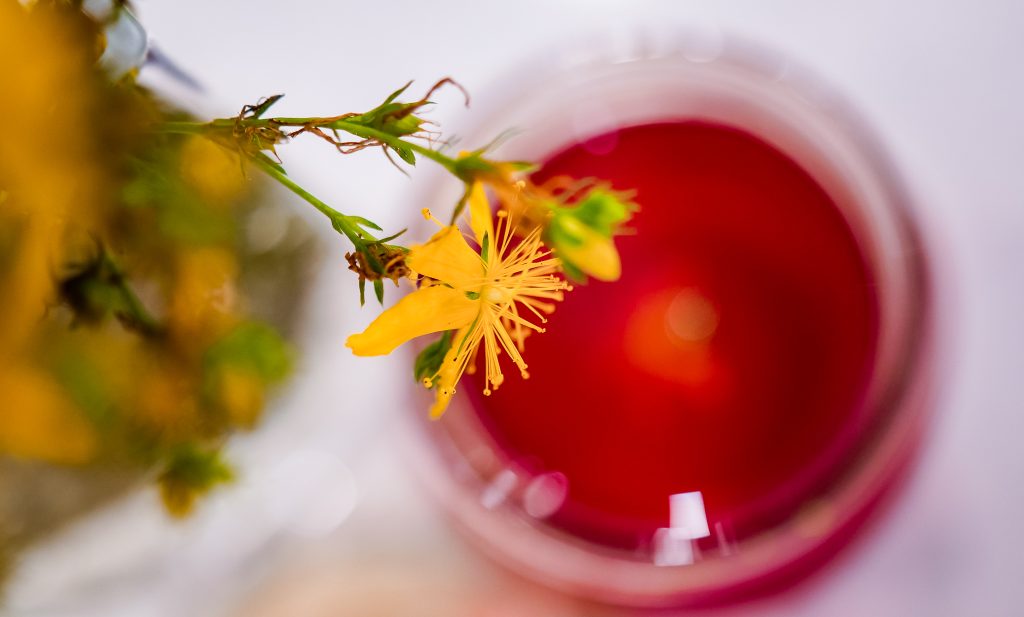
What oil should I use?
There are many pressed oils that will work quite nicely! (Expensive cold pressed oils will be wasted on the heating method)
- Olive oil – inexpensive, nourishing, and good for those with nut/seed allergies. It does have a stronger scent, but is my personal favourite for medicinal ointments.
- Sunflower oil – inexpensive and neutral in scent.
- Almond oil – excellent for dry and sensitive skins, light scent. A more expensive choice.
- Grapeseed oil – best for oily skins as it is light and easily absorbed. A more expensive choice.
What herbs should I use?
Here is a short list of some great herbs to try out for the first time. It is such an amazing feeling to go outside and pick fresh plants for your oil. The trick here is to let your herbs wilt first before adding to the oil. Wilting allows some of the water content to dissipate, preventing your oil from going “off” – rancid or moldy.
- Calendula petals (Calendula officinalis) – Infuses the oil with a beautiful golden orange colour. Amazing for all types of skin healing, a mild anti-microbial.
- St. John’s Wort flower (Hypericum perforatum) – Infuses the oil an amazing red colour. This oil has great success with nerve pain and aching joints. It is also an excellent remedy for the pain and scar reduction of minor burns. It is also anti-viral.
- Rose petals (Rosa spp.) – Pink and deliciously scented, great for cosmetic use and for calming & relaxing remedies.
- Comfrey (Symphytum officinale L.) – Sometimes called knitbone, this amazing green salve has been used traditionally to support superficial wounds, breaks, sprains, bruises, sprains & strains.
- Chickweed (Stellaria media) – Another lovely green salve which offers soothing relief to hot rashes, bug bites, wounds, diaper rash or any type of itchy skin condition.
- Plantain (Plantago) – This healing green salve aids in stings, bug bites, minor wounds, scratches, rashes and dry, irritated skin.
- Goldenrod (Solidago) – Is used topically for muscle cramps and sore muscles. Bonus: can be use to make salad dressing.
How do I infuse my Oil?
Traditional Sun method: my favourite!
This is such a simple way to make your oil! It is also the oldest and highest regarded way to make your infused oil. Simply fill a clear, wide mouthed jar ½ to ¾ with chopped herb, then top with oil. Shake gently to be rid of any air bubbles and ensure all herbs are covered with oil. Steep in sunny window or outside in the full sun, for approximate four – six weeks, shaking gently each day. Strain and pour into a sterilized storage jar and keep in a cool dark cupboard. Don’t forget to label and date!
Note: There are also Quick Pan and Slow Cooker methods if the infused oil is required quicker.
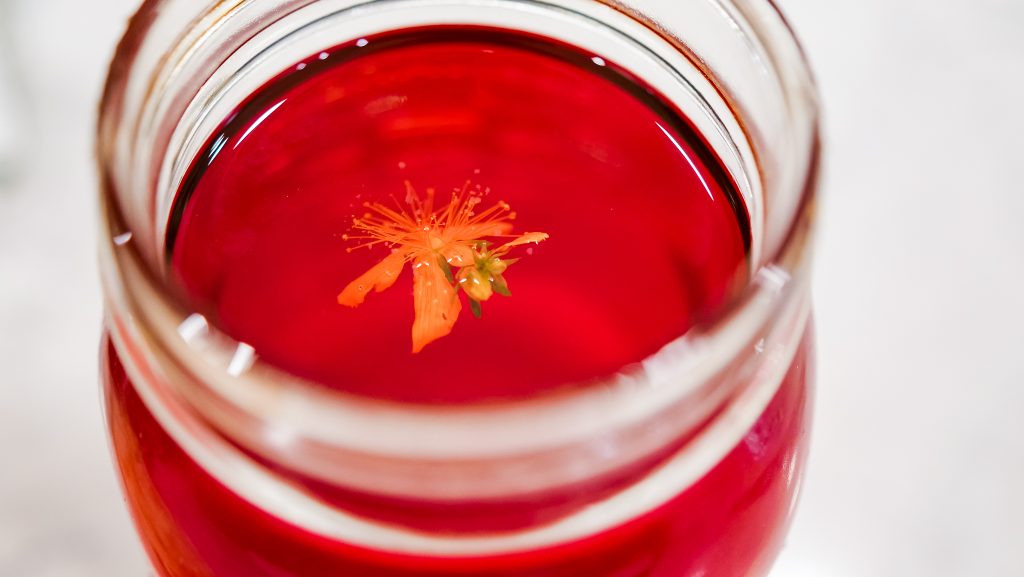
How Do I Make a Salve/Ointment?
Once you have your beautiful solar infused oil you are ready to make your salve… Now this is the magical part!
Take one cup of your infused oil and ¼ cup of beeswax; add to a stainless steel pot and place on burner. Heat low and slow until all the beeswax has melted. Test consistency of salve by taking a spoon full and placing in the freezer for ~5 min. If salve is too hard you can simply add a titch more infused oil to the pan, if too soft simply add a titch more beeswax to pan and melt. Your salve is now ready to pour into sterilized jars and let cool.
Voila! You have made your first salve – Whoot! Whoot!
Photos provided by Serena Mor
Medicinal Mushrooms
An Ancient Medicine
The use of mushrooms as food and medicine stretches back thousands of years, and can be observed in every culture of the world. Recently, a growing body of scientific and clinical evidence has amassed which supports many facets of the traditional use of mushrooms as medicine. Mycotherapy – the science of healing with mushrooms – is fully incorporated into traditional Western herbalism, as well as Traditional Chinese and Japanese medical systems, where mushrooms have always been highly revered as powerful healing agents for a wide variety of ailments and illnesses ranging from acute to chronic. Dr. Walter Ardigò, physician and researcher specializing in mycotherapy, suggests that mushrooms have such a strong affinity for so many diverse disease conditions in the human organism because of their biological similarities to human beings:
“Medicinal mushrooms are more similar to human beings than to plants. Like human beings, they need oxygen to live, eliminate carbondioxide and have no absolute need for light. The two also have similar biological mechanisms, such as immunity, cleansing and elimination of excess fluids” (Ardigò: 2017, 20).
Fungi play innumerable essential roles in maintaining the health and functionality of the world’s diverse ecosystems. It may surprise you, but the largest living being on earth has been declared to be a 2,384 acre large mycelial network (of the species Armillaria ostoyae, also known as honey mushrooms) located in the Blue Mountains of the state of Oregon. Fungi are responsible for processes involving the transmission of information amongst living organisms; they do this by way of electrical impulses that are sent underground through long, thread-like structures called hyphae, which expand to form mycelial networks. Many plants rely on mycorrhizal networks, which facilitate symbiotic associations between plants and fungi. Mycorrhizal networks serve to connect plants together and transfer essentials such as water, carbon, nitrogen, and a host of other nutrients and minerals.
Fungi also play an absolutely pivotal role when it comes to natural processes involving breakdown, decay and regeneration (e.g. by way of returning nutrients to the air and soil). Fungi do no simply decompose, but more accurately work to recompose elements of the environment. Fungi thereby make possible many of the processes of natural evolution. Fungi can be said to occupy a middle ground between the living and the dead; they are what allow for the continuum of coming into being and passing away to exist in the first place. As mycologist Peter McCoy expresses:
“Along the border of living and dying, mycelia sense and digest, interpret and destroy. More visibly than the bacteria with which they work, the fungi walk between worlds, acting as custodians of the darkness. Some species are so intimately tied to decay that they primarily live and fruit from dead animal parts” (McCoy: 2016, 76).
The Power of Mushrooms
That fungi are “custodians of the darkness” is suggestive of the fact that, when used as medicine, mushrooms can be helpful in a wide variety of psycho-emotional disorders, including many varieties of anxiety and depression, trauma and grief. As we will see, mushrooms such as Reishi can help to bring our unconscious defense patterns to light, making the darkness conscious through the metabolization of emotional experience. Additionally, when we understand the role that fungi play in decomposition and regeneration, we can also begin to understand how and why medicinal mushrooms prove so useful in diseases such as cancer and opportunistic infections such as might be associated with HIV. Both of these conditions involve uncontrolled, proliferative growth that the body is unable to keep in check. Medicinal mushrooms act in such a way as to regulate the functioning of the immune system, keeping such pathological conditions in check or preventing their onset in the first place.
Many of our medicinal mushrooms act as adaptogens. In general, adaptogens serve to strengthen the natural defenses of the body, and help the body adapt to non-specific stressors (including physical performance and endurance, as well as psychological and emotional stress). Adaptogens have a normalizing or balancing effect on the whole organism, helping to promote equilibrium amongst different body systems and processes. Many adaptogens have a direct strengthening and rehabilitative effect on the adrenal glands, are known to help to regulate blood sugar levels, and to balance and stabilize hormone levels. Used in moderation, adaptogens are generally very well tolerated by most people and help to promote an overall harmonizing and tonifying effect on the body and mind.
Shiitake
Lentinula edodes
Shiitake is a well-known culinary and medicinal mushroom that has been used in Asian cuisine for at least 2000 years, with cultivation techniques originating in Japan about 700 years ago. The name “shiitake” is derived from the Japanese words “shii” meaning oak, and “take” meaning mushroom: suggesting that shiitake is the mushroom that grows on oak trees. Shiitake is the second most consumed mushroom worldwide, second only to agaricus mushrooms. In Japanese culture, shiitake is considered to be a tonic food substance which serves to increase energy, foster the resilience of the body, reduce the susceptibility to chronic degenerative diseases, aid in convalescence, and slow the aging and deterioration process.
Many clinical studies on Shiitake focus on its production of the beta-glucan lentinan. Beta-glucans are a type of fiber that has an affinity for promoting the health of the heart, regulating the function of the immune system, and balancing cholesterol and blood sugar levels (shiitake is known to be an excellent food for diabetic patients). Lentinan is a unique beta-glucan that is found in shiitake mushrooms, which has been given increasing attention in recent years due to its utility in assisting in the treatment of cancer and HIV infection. Many of the medicinal properties of lentinan relate to its ability to stimulate macrophages (a type of white blood cell in the immune system that engulfs and digests pathogens including cancer cells, foreign substances and harmful microbes), T-cells (which target specific foreign particles in the body), B-cells (an important component of the adaptive immune system), and NK cells (essential to the functioning of the innate immune system). Researchers have also focused on shiitake’s production of the polysaccharides LEM and LAP, which possess significant antitumor activity. LEM has been shown to stimulate the proliferation of a specific type of T-cell which can help to neutralize hepatitis and slow and prevent the rapid development of HIV infection. Shiitake possesses anti-viral and antioxidant properties, in part due to the presence of the essential trace mineral selenium. Selenium plays a role in many bodily functions, especially maintaining thyroid hormone metabolism and DNA synthesis, safeguarding the body against oxidative damage and infection. Shiitake is also useful in diseases of the intestine, respiratory tract, liver, bones and teeth. It has been called on for centuries as a household remedy to help treat flu and fever, coughs and colds and allergies.
There is a growing body of research on shiitake mushroom, which was the first mushroom to receive in depth research by modern scientists. As Ardigò explains:
shiitake “became renowned in 1964, after the Japanese health authorities decided to promote a series of epidemiological studies on the prevalence and distribution of the main chronic diseases throughout the country. The results revealed a very peculiar situation: in two areas of the country, disease was almost entirely absent, and the population was very long-lived” (Ardigò: 2017, 287)
The homeopath Massimo Mangialavori relates that:
“there are many myths and customs associated with shiitake. One belief is that this mushroom grows best in the company of other nurse logs, rather than by itself. Some say the mushroom is sensitive to the attitude of those who tend the mushroom: positive people allow it to flourish; disagreeable people discourage its growth” (Mangialavori: 2017, 263).
Maitake
Grifola frondosa
The general uses of maitake mushroom include the treatment of obesity (the alpha-glucosidase inhibitor contained in maitake decreases the amount of starch that is digested into sugar), diabetes type 1 and 2 (maitake lowers blood glucose levels and enhances insulin sensitivity), a wide variety of tumors but especially those of the stomach and lungs (maitake enhances macrophage activity in the body), leukemia, allergies, and HIV. Maitake has an affinity for conditions of the heart, including hypertension and high VLDL and HDL cholesterol levels. It is also known as a hepatoprotective mushroom, serving to enhance the overall health and functionality of the liver while simultaneously protecting it from damage. It is widely used in hepatocellular cancer and other pathological and chronic conditions that affect the liver, such as hepatitis.
Herbalist Richard Bray comments on the geography and preferred growing conditions of maitake and on the origin of one of its common names, hen of the woods:
“Maitake grows primarily at the base of oak trees in eastern North America, China, and Japan. This polypore mushroom starts as a small fruiting body, about the size of a potato, and when mature reaches up to 2-7 cm across. They grow especially big in Japan, often reaching 45kg. It is known as the “king of mushrooms” there with good reason! Maitake mushrooms grow multitudes of overlapping grayish-brown fronds, which give it the appearance of a hen sitting in the woods, hence the common name” (Bray: 2020, 48).
Lion’s Mane
Hericium erinaceus
Lion’s mane is most well known for its ability to induce brain tissue regeneration and to enhance perceptual capacities. If you look at either fresh or dried lion’s mane, you’ll observe that it appears structurally similar to the human brain and its nerve fibers – a clear example of the doctrine of signatures. Lion’s mane is used in the treatment of such issues as dementia, Parkinson’s, and diabetic neuropathy. The polysaccharides and polypeptides in Lion’s mane help to enhance immune function and have proven useful in stomach, esophageal, and skin cancers. Lion’s mane can pass through the blood-brain barrier and as such is quite valuable for targeting lyme disease spirochetes that have invaded the brain. Lion’s mane directs the spirochetes into the bloodstream where there’s a chance of them being eradicated. There are a growing number of studies that suggest the utility of lion’s mane in treating a variety of types of depression and mood disorders, including hormonally related anxiety disorders.
Indications from Traditional Chinese Medicine include memory disorders, difficulty concentrating, and a general picture of deficient cognitive function and abilities. Traditional Chinese Medicine also recognizes the use of lion’s mane in promoting and maintaining the health of the kidneys, heart, liver, lungs and spleen. It is thought to enhance overall strength and vitality, and facilitate ease of digestion. Ardigò comments:
“in traditional Chinese medicine it has long been used to treat diseases of the stomach, nervous system and nerves, to improve the immune system and to restore the natural strength of the body, because it has an important action in improving energy and cognitive functions. To highlight its many benefits for physical and cognitive activities, the ancient sages have even coined the saying “Hericium nerves of steel and the memory of a lion”” (Ardigò: 2017, 280).
Reishi
Ganoderma spp.
Lingzhi, the name given to ganoderma species in Traditional Chinese Medicine, literally translates as “Supernatural Fungus.” Reishi is also known as “The Mushroom of Immortality.” The physician and scholar Li Shi Zhen (1518 – 1599) wrote that reishi is:
“biter in taste, warm in nature, not poisonous, and replenishes the life energy, or qi of the heart. It increases intellectual capacity while nurturing the body, and banishes forgetfulness; taken over a long period of time, agility of the body will not cease; it keeps the body light and youthful like a celestial being” (quoted in Mangialavori: 2017, 284).
Reishi acts as a cardiovascular, lung, immune and nervous system tonic and restorative, improves circulation and oxygen utilization, promotes deep sleep and undisturbed thought patterns, generates a heightened sense of peacefulness, helps to process stagnant emotions held in the body, and deepens one’s trust in one’s own innate capacities and potentials. As Ron Teeguarden expresses it:
Reishi “calms the mind, eases tension, strengthens the nerves, improves memory, sharpens concentration and focus, [and] and builds willpower”, thus earning it the title “the Mushroom of Spiritual Potency” (Teeguarden: 2000, 88).
Reishi is a medicine that typically is best worked with over a longer period of time, having cumulative effects that gradually build the resilience of our nervous system and transforming the ways in which we relate to and perceive life itself. Reishi is highly esteemed as a medicine in virtually all of the cultures that have access to it, as Ardigò writes:
“Ganoderma, in fact, is known more or less everywhere, not only in Asian countries. For example, research shows that the indigenous peoples of Mexico used it in a number of diseases and in particular for heart disease, both for prevention and treatment” (Ardigò: 2017, 258).
In Traditional Chinese Medicine, reishi is considered to be a supreme Shen tonic, which is to say that it has a special affinity for the spirit, mind, and emotional body. Shen is considered to be the spirit that resides in the heart, or the heart-mind connection. Hence reishi’s reputation as an adaptogen involves its ability to teach us how to develop the inner resources with which we can navigate emotional and spiritual conflicts, and to confront and effectively work through a variety of psychological blockages and obstacles. Reishi has a long reputation in Daoist spiritual traditions as a medicine that promotes wisdom, longevity, groundedness and calmness. As a long living mushroom known to grown in old and mature forests, reishi carries with it the ability to connect us to the nature’s cycles of life, death and rebirth.
Reishi is not only useful for the emotional and spiritual levels of the mind, but also for sharpening cognitive and intellectual abilities and improving concentration and focus. Ardigò comments:
“Ganoderma has also been used at a mental and psychological level, to reduce lapses in concentration, to sharpen intelligence, to improve memory, to strengthen will-power, to relax a distressed and restless mind” (Ardigò: 2017, 258)
Other uses of reishi include: coronary heart disease, heart arrhythmias, feelings of tightness and constriction in the chest, chronic asthma and bronchitis, altitude sickness, vertigo, hypertension, high cholesterol, insomnia, diabetes, hepatitis, cancer, allergies, chronic fatigue syndrome and a variety of conditions involving chronic pain (Mangialavori: 2017, 284 – 285).
Looking into the Future
The future is bright when it comes to medicinal mushrooms. Every year, a greater number of people are becoming involved with the powerful medicine from the kingdom of fungi. From mushroom cultivation to mycoremediation (the use of fungi to help repair and restore damaged and polluted ecosystems), from the treatment of cancer and diabetes to complex emotional and psychological conditions, mushroom medicine can no longer be ignored. More than a passing trend, mushroom medicine is being shown, both by practitioners of natural healing and research scientists from around the world, to offer sustainable and lasting solutions to a wide variety of personal and social health problems. A great deal more will be revealed to us in the years to come as clinical and scientific exploration moves forward and continues to expand in novel and exciting directions.
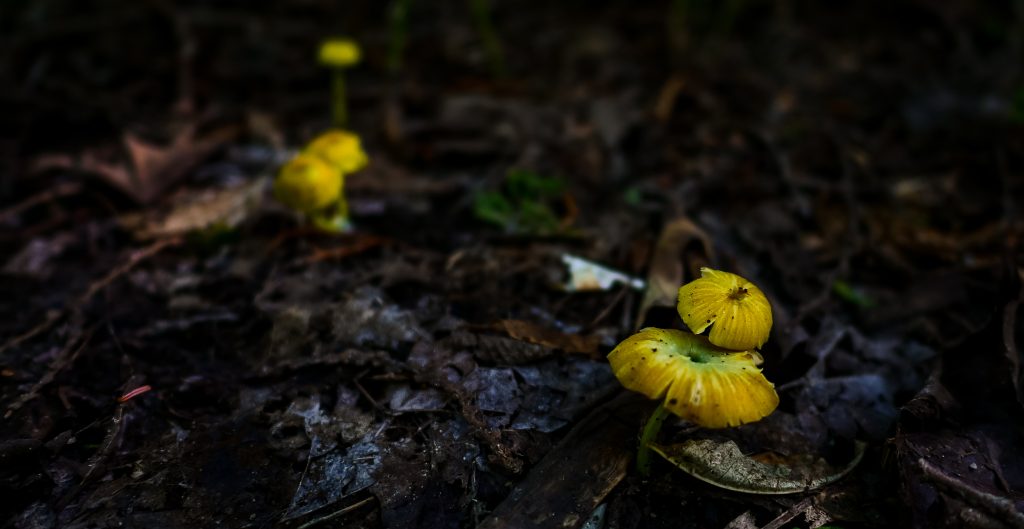
References and Recommended Titles:
- Ardigò, Walter. Healing With Medicinal Mushrooms: A Practical Handbook. Self published: 2017.
- Bray, Richard. Medicinal Mushrooms: A Practical Guide to Healing Mushrooms. Hamburg: Monkey Publishing, 2020.
- Mangialavori, Massimo. Materia Medica Clinica vol. 2: Fungi. South Carolina: CreateSpace, 2017.
- McCoy, Peter. Radical Mycology: A Treatise On Seeing And Working With Fungi. Portland: Chthaeus Press, 2016.
- Rogers, Robert. The Fungal Pharmacy: The Complete Guide to Medicinal Mushrooms and Lichens of North America. Berkley: North Atlantic Books, 2011.
- Sheldrake, Merlin. Entangled Life: How Fungi Make Our Worlds, Change Our Minds & Shape Our Futures. New York: Random House, 2021.
- Stamets, Paul. Mycelium Running: How Mushrooms Can Help Save the World. Berkeley: Ten Speed Press, 2005.
- Teeguarden, Ron. The Ancient Wisdom of the Chinese Tonic Herbs. New York: Grand Central Publishing, 2000.
Photos Provided by Serena Mor
Top 10 Best Practices for Herbalists
“Giving back and acting in a way that is regenerative, benefits us all”
– Penelope Beaudrow
1. Know your Endangered & At-Risk Species
Whether you’re foraging yourself or purchasing herbs at your local natural health food store, it is very important to know the circumstances around the plants you are working with. When it comes to species at risk, it is always recommended that you purchase herbs that are sustainably grown and cultivated and to avoid foraging or wildcrafting (as much as this part of herbalism is often a favourite!). This helps maintain the wild population and helps promote the livelihood of these endangered species. As well, there are often many substitutes for those that are at-risk, and this can be a great approach to avoid harming the population altogether. Alternatively, if no substitute can be found, then it is always recommended that actions are taken to give back what you’ve taken, and then some. For example, if you’re purchasing Goldenseal (Hydrastis canadensis), which again should be purchased and not foraged, it would be recommended that you plant some of your own. Whether that means planting in your own garden, or sprinkling seeds on your favourite trail – regardless of how, there are a ton of ways you can give back to help encourage the repopulation. For more information and resources, contact your local conservation group or management area or get connected with groups such as the United Plant Savers, or visit a local sanctuary – like Penelope’s sanctuary; Kina Kegoo, in Cannington, Ontario (sanctuaries can also be found listed at UPS!)⁷. More information can also be found on your government’s website.
2. Choose Your Resources Well
It is important to remember that the magic and medicine of plants are only as good as the quality of the plants themselves. These days, where herbs are being cultivated and sold in abundance, it can be easy to overlook the quality of the plants, especially underneath the often appealing packaging. It’s safe to say that growing your own is always recommended, as it gives Herbalists the opportunity to get to know the plants they’re working with and helps foster a tangible and therapeutic relationship that comes along with it. Whenever possible, if not growing your own, herbs should be purchased and grown locally. Not only just to support our farmers, but so you can gain a better understanding of the growing methods and so the plant material doesn’t have to travel as far (often along the way, herbs are sprayed through inspections in order to meet guidelines and regulations, which can be avoided purchasing directly from the grower). However, if that’s out of the question, it is wise to always look for herbs that are organic, forest-grown or wildcrafted. As many great healers would say, wildcrafted and/or organic signify that the herb was collected or grown with conscious awareness of the plant’s life cycle, and was picked according to the seasons, at the right time of day, and dried in the best drying conditions. It implies a certain conscious responsibility of the environment and the non use of chemical fertilizers or sprays¹.
3. Honouring your Harvest
An easy rule of thumb: always leave an area as beautiful as you found it; keeping in mind the animals, pollinators, germinated seedlings, and seeds left behind. It is also recommended and highly encouraged that you ask permission of the plant, which can be done by sitting with intention to take it and noticing how it feels, or directly through holding the plant in your hands. Like a grazing animal, it’s mindful never to take everything you’ve found, but rather take a little bit here and there along the way, leaving as much of what you can behind.
In addition, most of the land that we take ownership of was first tended to by the Indiginous Peoples of Canada, who understood that we are impermanent stewards of this earth, and we must take care of it with what little time we have. Many similar ceremonies and rituals can still be practiced today, or by creating those of your own, doing what feels authentic for you. At the end of the day, it’s important to pay respects to the plants that came before us, and for those that long outlive us – however that might look for you. You can even speak or say to yourself a land acknowledgement, such as, “every community owes its existence and vitality to generations from around the world who contributed their hopes, dreams, and energy to making the history that led to this moment. Some were brought here against their will, some were drawn to leave their distant homes in hope of a better life, and some have lived on this land for more generations than can be counted. Truth and acknowledgment are critical to building mutual respect and connection across all barriers of heritage and difference. We begin this effort to acknowledge what has been buried by honoring the truth.”
4. Learn your Alternatives & Substitutes
Though it can be difficult to find a single plant medicine with the same mechanism of action as our endangered native plants, herbs are diverse and there are many options on plants that have a few similar medicinal properties that can be used instead. For example, one can use Berberine from Amur Cork Trees or Barberry instead of using the aforementioned Goldenseal. With that being said, whenever foraging, make sure you know the plant you are about to harvest, to avoid accidentally wildcrafting species at risk. There is a great Analog List created by Jane Bothwell to help navigate through choosing a less threatened species, and a great quote from her publication on United Plant Savers:
“When cultivated species are not available, then it is best to find a plant analog. An analog is an herb having a parallel action, function or end result to other medicinal herbs. In most instances, it is important and necessary to use a variety of analogs for the at-risk herb because an analog generally satisfies only some of the therapeutic actions of a particular plant species and does not demonstrate all medicinal actions of that plant. It is sometimes difficult to find replacements for our tried and true herb friends, but it also can be very satisfying and will expand your expertise, while helping to replant our future. Choose alien (non-native) plants for food and medicine, leaving the more fragile native plant species to flourish. Many alien plants are extremely powerful medicinals and will be a welcomed addition to your medicine chest.”²
5. Find Ways to Give Back
Of course there are many ways in which Herbalists and natural healers alike can do their part, and it doesn’t always have to create work. In some cases, doing nothing is doing something. Take for example rewilding – it is estimated that 20% of the earth is covered in grass, much of this being maintained lawns that are wasteful and void of diversity. Instead, If let be, these areas can slowly become diverse ecosystems, holding space for native species to come back, or even utilizing these newfound areas to plant native and endangered species. This also helps insects and animals find new homes and allows more plants to flower for our vulnerable pollinators! Needless to say, rewilding can help heal the wounds we’ve long since inflicted⁹.
For more information on rewilding, what it is and how to do it, there’s a great short film with Penelope Beaudrow, where she shares how her family’s land has evolved into what has become a thriving place for threatened and at risk medicinal and native plants, as well as how the work on their farm and sanctuary gives back to the land and animals that live here and benefits us all, and some of the things you can do to help make a difference.³
Another preservation action you can take, is to save plants that are soon to be destroyed by developments and transplant them somewhere safe, be it your lawn or someone else’s. This one may take getting your hands dirty and a little bit of heavy work, but the payoff is rewarding and the opportunities to do so are endless.
As Tao Orion beautifully puts it, “Native plants are not just native to a place, they are essential elements of a culture that stewards them. Native species like milkweed, echinacea, trillium, bloodroot, dwarf trout lily, elderberry, huckleberry, hickory and countless others are not just wildflowers but food, medicine, fiber, shelter, tools.”¹⁰ Once we can change the way we see the the world around us, the world around us begins to change.
6. Give Thanks
Some Indigenous peoples have a tradition of leaving tobacco after gathering, as a way to show their gratitude for that which was taken. In the same way, every Herbalist can offer thanks in some way that feels authentic to them, whether by saying a few words or leaving something behind. You can also do some research on what rituals (if any) your ancestors may have practiced regarding reciprocity that may have been lost, and that you can rekindle and bring back into your own practice.
When it comes down to it, there are so many meaningful ways to insert ourselves into nature in a way that shows gratitude through action – causing a ripple of change through everything we do. Through stewardship of the land we can mediate disturbances to create high density areas, refashion long standing relationships with landscapes that provide for our needs, and work to prioritize habitat connectivity by envisioning a continuous corridor of wild spaces that butterflies, birds, lizards, frogs, skunks, bobcats, and bears move through,¹⁰ to name a few examples.
Whatever your way, always be mindful of the concept of exchanging rather than taking and bringing awareness of the symbiotic relationship between humankind and the plant kingdom.
7. Know your Symbols
When it comes to ethical purchasing, being able to understand the symbols and indications on packaging can be very important to help you purchase the most sustainable option possible. Oftentimes when we go into our local natural health food stores it can be hard to get a clear idea of where what you’re buying came from, but understanding your symbols can help bring some transparency to this supply chain process.
When it comes to Certified Organic labels, these standards vary by province and state, so look into your government’s website to learn more about what entails of this certification. Though, it’s safe to say, seeing an organics label is better than not seeing one at all. You may also see things like wildcrafted; meaning plants are collected directly from their natural wild habitat such as forests, fields and undeveloped areas of land, and they should be unadulterated by chemicals such as fertilizers and pesticides. This of course is something that should be avoided when in search of at-risk or endangered species, but for all other herbs, it’s almost always a good indicator of quality. Forest-Grown is another great attribute to look out for; whereby each verified forest farmer has a dynamic story of land stewardship, often taking decades of dedication to grow the forest botanicals in their care⁵.
So whatever your label, make sure you understand what you’re buying before you spend your hard earned dollars.
8. Empower Yourself
Considering everything is made up of energy, growing your own herbs can be wonderfully therapeutic for yourself, loved ones, and community. From the very beginning your devout care and attention goes into watching your seeds sprout into seedlings, all the way up until they’re ready to harvest – allowing the plants to become a vessel of your attentive nurturing, embodies the reciprocate and synergistic relationship between us and the plants.
One of our favourite local places to get all of our essentials is Richters Herbs. They offers plants, seeds, books, dried herbs and so much more⁶.
9. Get Educated
In Canada, most endangered species live in the south, which is also where most of us humans live. It’s no coincidence: there are more species in the south where the climate is warmer, and people have transformed southern landscapes to make way for agriculture and cities. We live in close proximity to many endangered species, yet many of them fly under our radar – especially the plants⁸.
However, there are so many ways to continue your education and to earn credits each year on endangered and at risk plants in your area. The awareness that comes along with staying current and aware of these plants can be of huge benefit to your practice, and to the world around you. It is to be noted that each province and state has their own list of endangered plants, which you can refer to and begin to pay homage to. This can also be a fun activity to do by yourself or with family: anytime you travel to new towns or cities, keep a lookout for any you can find or purchase seeds to bring with you ahead of time to sprinkle along your journey!
There are many organizations and conferences that are now offering lectures on at-risk and endangered species, such as the Ontario Herbalists Association, Back to Your Roots Herbal Retreat, Heartwood, Canadian Herb Conference, American Herbalist’s Guild, and National Institute of Medical Herbalists.
10. Be the Educator
Share as much information as you can within your own social circles, family, and community. The more widespread the information, the more that can be done about it! Plus, this is a great way to bring communities together and enjoy activities together like planting in local parks, going on identification walks, and through speaking and sharing with local garden groups and clubs, and even schools.
Change starts with you, and the ripple never stops once it starts!
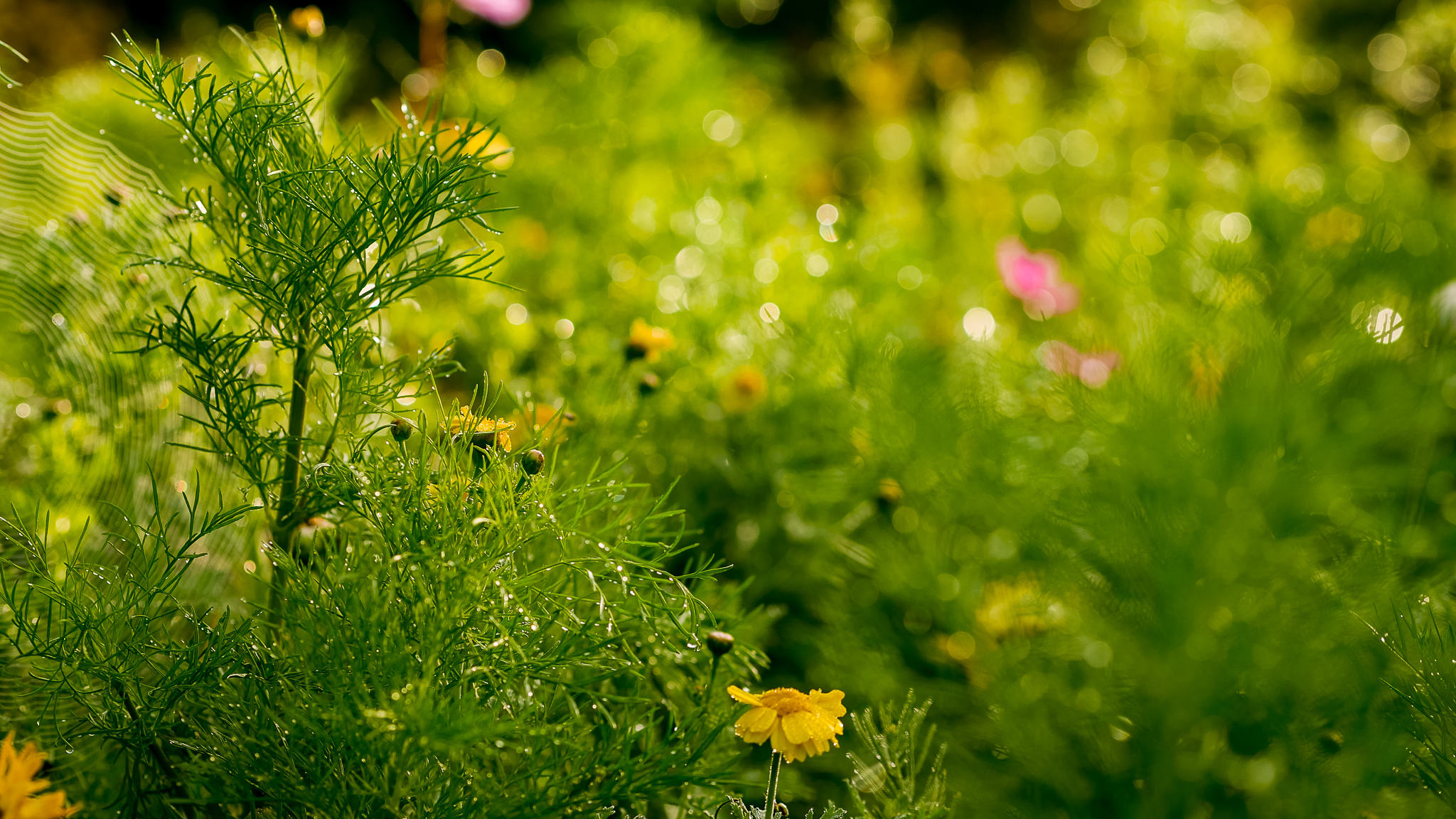
Post Contributors:
Penelope Beaudrow, RH
Penelope Beaudrow is a Registered Herbalist and educator who has devoted the past 25 years to helping others foster deep and resilient connections with the living intelligence of the natural world and the regenerative, healing forces of plants and the medicine they carry.
Chelsea Vieira, Community Herbalist
Chelsea is a community herbalist and an all-around plant enthusiast. From a young age being fond of the wonders of the natural world, she’s since gone on to help others reconnect and rekindle this relationship, and the magic it encompasses.
References:
¹ Rosemary Gladstar. The Science and Art of Herbalism. Lesson One, page 6.
² Jane Bothwell. UPS List of Herbs & Analogues.
³ Penelope Beaudrow. For the Love of Medicinal and Native Plants. Everything Herbal, 2021.
⁴ Penelope Beaudrow, Lauri Hoeg. Sacred Plants – Spiritual and Medicinal Uses. Everything Herbal, 2021.
⁵ United Plant Savers. Forest Grown Verified Program, 2019.
⁶ Richters Herbs, 1969.
⁷ The Ginkgo Tree. Kina Gegoo Botanical Sanctuary. UPS Member, 2015.
⁸ Jenny McCune. The Endangered Species Hiding in Plain Sight. Canadian Geographic, 2019.
⁹ David Suzuki. Rewilding can help heal wounds we’ve inflicted. David Suzuki Foundation, 2021.
¹⁰ Tao Orion. Beyond the War on Invasive Species. 2015.
United Plant Savers, Become a Herbal Business Member.
Government of Ontario. Species At-Risk in Ontario, 2020.
United Plant Savers. Medicinal Plant Conservation Certificate Program.
The Canadian Encyclopedia. Endangered Plants in Canada, 2021.
United Plant Savers. Species At-Risk Assessment Tool. Downloads and resources.
Canadian Wildlife Federation. Canada’s Plants in Peril.
Photos provided by Serena Mor
Magic, Healing & Ritual: Herbal Tradition in the Italian Renaissance
Angels, Demons, Herbs and Magic
The ancient, and now largely lost and forgotten, tradition of illuminated herbal manuscripts can tell us much about the practice of herbal medicine throughout antiquity. It was not uncommon for such manuscripts to contain drawings of angels and demons, mythological figures and beings of the celestial hierarchies. Witchcraft and magic were taken to be very serious matters, not only when it came to cultural and religious belief systems, but also when considering the proper training of a physician. As one author writing on traditional Italian healing systems in antiquity has commented:
“Physicians were educated with the notion that drugs had occult powers to affect the body in special ways. It was common belief that demons invaded the soul, and that certain herbs had the property of chasing away devils and demons” (Silberman: 1996).
Expert Italian Renaissance physicians were required to be competent in astronomy and astrology “since the position of the celestial bodies contributed to the occult qualities of a medicinal herb” (Silberman: 1996). The Renaissance, as reflected in the writings of prominent philosophers of the time such as Giordano Bruno and Marsilio Ficino, saw a resurgence of pagan sensibilities. Renaissance thought and imagination embraced an animistic worldview that threatened the established, conservative branches of Christianity and their associated medieval superstitions. As the archetypal psychologist James Hillman writes:
“Renaissance animism led to pluralism, which threatened Christian universal harmony. For when inner soul and outer world reflect each other as enlivened souls and substances, and when the images of these souls and substances are pagan, then the familiar figures of Christianity diminish to only one relative set among many alternatives.”
This co-reflection or mirroring of the inner soul and the outer world are the life-stream of the ancient pagan and Renaissance herbal medical traditions of Italy and surrounding regions. This conception of a pluralistic world and of the enlivened human soul seen as a microcosmic reflection of the greater soul of nature helps us to understand the associations and correspondences that were made between particular herbs, supernatural, celestial, and divine beings, and the actions of the planetary bodies in the medicine of the time.
Medicina Antiqua Illustration depicting mandrake harvesting
Christianity and Paganism
In the Middle Ages there was much scorn for the Pagan worship of Goddess nature (who is synonymous with Venus or Aphrodite). This too is reflected in the medical manuscripts of the day. Consider, for example, the “editing” or erasure of an invocation to Gaia found in an early 13th century Viennese manuscript, Medicina Antiqua, by an unknown monk living sometime later in the Medieval period. The erasure in question was found on the back of an image depicting the invocation of the divine mother.
“She stands in classical clothing on the banks of a river in which the river god Neptune can be seen sitting with his trident on a snake. Mother Earth holds a cornucopia in her arms and is surrounded by stylized palms and fantasy plants.” (Müller-Ebeling: 2003, 184).
The fifty-one line invocation on the back of the image originally began “Sacred Goddess Earth, bringer of natural things…” but was changed to “To the Sacred God…” by the monk in question. In the 15th century, much of Northern Europe “fought hard for a reformation of the religious and moral foundations of spiritual life” but in sunny Renaissance Italy there was to be found an opening and renewal of the senses, a “rediscovery of classical sculptures of the gods as well as to texts that were bought from the cloisters by…Cosimo de’Medici” (Müller-Ebeling: 2003, 180).
Italian philosophers and artists of the time were concerned with understanding and exploring nature’s beauty and “the congenial side of the human character [was given much greater attention than was] the sinful” (ibid). A comparison of Germanic and Italian art of this period can be quite revealing; the former tradition is full of images of infernal hells (e.g. Hieronymus Bosch), the latter dedicated to an exploration of anatomy and perspective rooted in a renewed pagan grace (e.g. Leonardo, Raphael, Michelangelo). For confirmation of this claim, one can for example study the encoded pagan symbolism present in Michelangelo’s anatomical drawings.
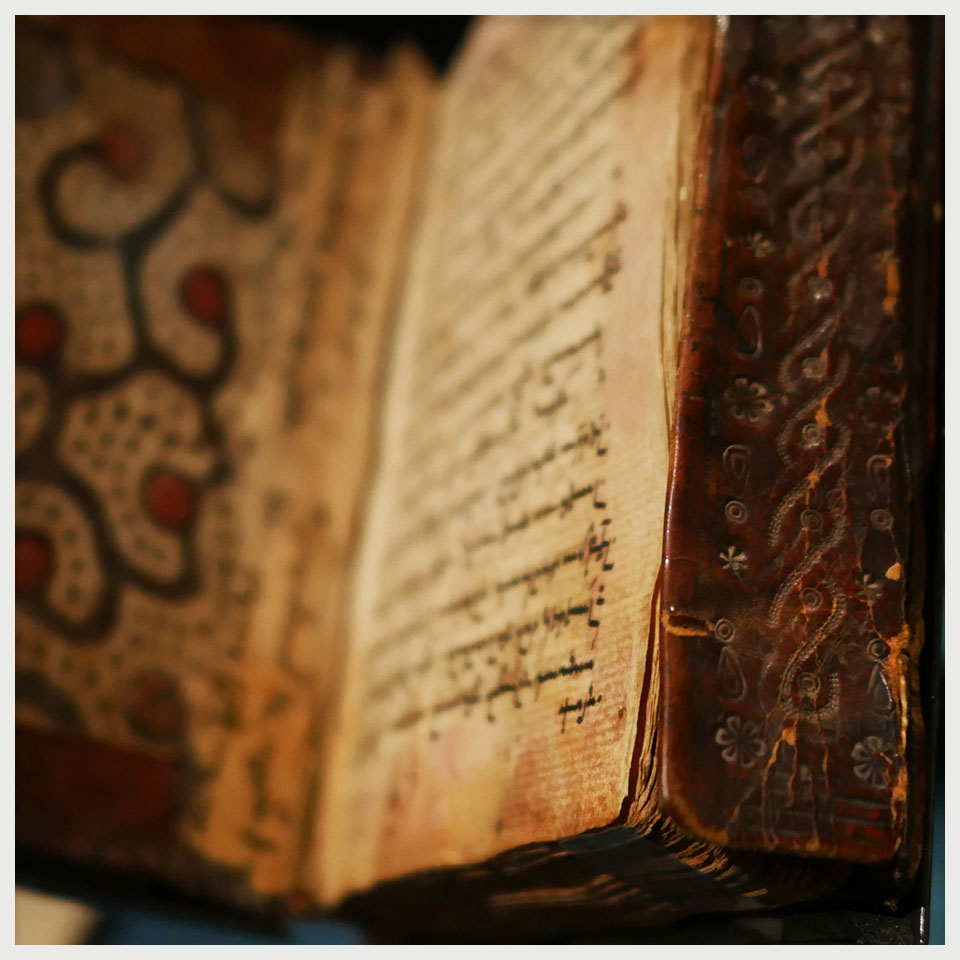
Pictured: 17th Century Bible
Given the church’s disdain for nature worship and resurgent pagan sensibilities, it is no wonder that Giordano Bruno, the Renaissance magi who considered medicine to be a branch of natural magic, was eventually burned at the stake for heresy (in particular, he was put to death for his belief in an infinite number of worlds). In his treatise De Magia Bruno provides a list of ten definitions of the words magic and magician. The one that especially interests us reads as follows: “Magician: someone who does wondrous things merely by manipulating active and passive powers, as occurs in chemistry, medicine and such fields; this is commonly called ‘natural magic’” (Bruno: 1998). For Bruno, the natural world and the divine world reflected and interpenetrated each other. To use and to understand herbs was to know, in the sense of gnosis, the action of divinity in nature; it was also to realize that through the work of learning to read the book of nature that one in turn serves to illuminate the divine:
“… for as the divinity descends in a certain manner inasmuch as it communicates itself to nature, so there is an ascent made to the divinity by nature, and so through the light which shines in natural things one mounts upward to the life which presides over them” (Bruno quoted in Yates: 1940, 183).
Bruno also gives us an insight into the common practice of using incantations and physical traces left behind by or belonging to a person to affect a cure or to set a curse in motion:
“Wicked or poisonous magic: incantations are associated with a person’s physical parts in any sense; garments, excrement, remnants, footprints and anything which is believed to have made some contact with the person. In that case, and if they are used to untie, fasten, or weaken, then this constitutes the type of magic called ‘wicked’, if it leads to evil. If it leads to good, it is to be counted among the medicines belonging to a certain method and type of medical practice. If it leads to final destruction and death, then it is called ‘poisonous magic’ (Bruno: 1998).”
Hellebore and Mandrake
Not all figures of the Italian renaissance shared the magical and animistic views of Bruno, and the more “rational” voices of the time thought that Bruno and his ilk were quite mad. But even among the more conservative authors, herbal medicine was still widely referenced and bound up with mythological associations. The famous poet Torquato Tasso took issue with Bruno’s worldview and in discussing his work quoted Erasmus’ phrase “Anticyram navigat”, literally ‘set sail for Anticyra’. Anticyra was a place that was known to contain an abundance of the herb hellebore (Veratrum album), then used as a cure for madness (Yates: 1940, 191)). Let us turn to consider this herb, and the related mandrake (Mandragora officinarum), both of which can serve to give us some insights into the practices and belief systems that existed in the Italian herbal tradition, especially the tradition maintained by the rhizotomes, or root diggers, the magician-herbalists of the ancient world.
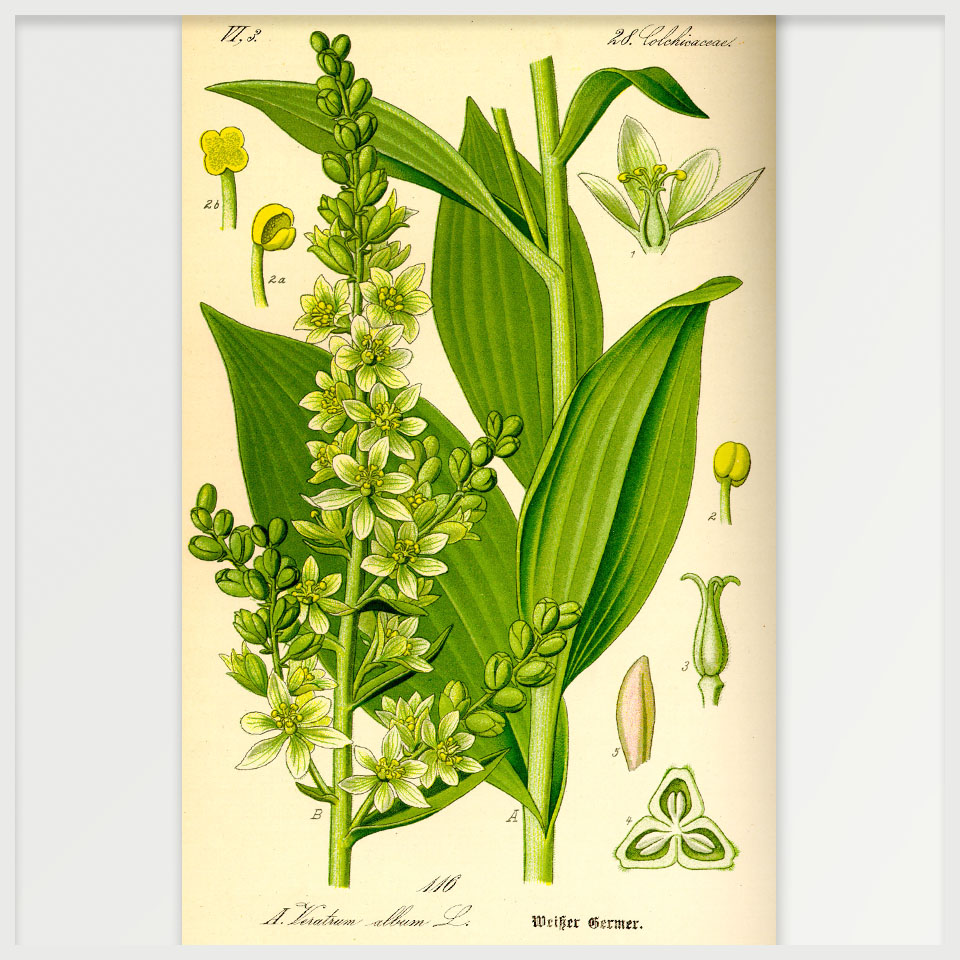
Hellebore (Veratrum album, white hellebore, veratro bianco in Italian); Helleborus niger, black hellebore) was a very important herb not only in ancient and renaissance Italy but also in Greece, France, and Egypt, among other places. Theophrastus maintained that the two types of hellebore were the most important medicinal plants that were used in ancient Greece and Rome. Contemporary ethnobotanist Christian Rätsch says of the hellebores: “they were the central medicines of the rhizotomes, diggers who nourished the magical plants with shamanic rituals. Hellebore was a sacred plant of the gods” (Rätsch: 2005, 525). Rätsch speculates that name helleboros is derived from hella-bora, which means “food of Helle.” The Hellespont is named after Helle who fell into this body of water after narrowly escaping death. Helle’s stepmother Ino resentfully roasted all of the seeds in the region of Boeotia so that a massive famine would result; this famine she blamed on Helle and her brother Phrixus, the stepchildren she so hated, in a ploy to have them killed. However, a flying golden ram sent by their birth mother Nephele saved these two. Helle fell from the ram into the Hellespont, where she was saved by Poseidon and metamorphosed into a goddess of the sea (in some less interesting accounts of the myth Helle simply drowned).
Rätsch argues that the most important documented use of this herb involved turning the root into a snuff. This is because “the artificially induced sneezing (the German name nieswurz means “sneezing root”) was believed to cause the demons of sickness to leave the body” (ibid). The Greeks and the Romans used the white hellebore1, which was ritually harvested in a way similar to the mandrake (Mandragora officinarum). Pliny gives a detailed account of the uses of white hellebore, which also gives us insight into the nature of medical treatment in the Rome of his time:
The body must be prepared beforehand for seven days by spiced food and abstention from wine, on the fourth and third day through vomiting, on the day preceding through fasting. White hellebore is also given in something sweet but is best in lentils or in a mush… The emptying begins after about four hours; the entire treatment is over in seven hours. In this manner, white hellebore heals epilepsy, …dizziness, melancholy, insanity, possession, white elephantiasis, leprosy, tetanus, tremors, foot gout, dropsy, incipient tympanic water, stomach weakness, charley horse, hip pains, four-day fever, if this will not disappear in any other way, persistent coughing, flatulence, and recurrent stomachaches (Pliny quoted in Rätsch: 2005, 527).
Consideration of the harvesting rituals common to hellebore and mandrake can give us interesting insights into the practices and beliefs of the rhizotomes as they engaged their art in Greek and Italian herbal traditions. The harvesting of these two plants involved many preliminaries and precautions. “Naturally a weird story of perils incurred in obtaining a plant strengthened belief in its magic powers and added to its commercial value” (Randolph, 489). Theophrastus describes the practices of the root diggers in his History of Plants, with specific reference to the mandrake: “Around the mandragora one must make three circles with a sword, and dig looking toward the west. Another person must dance about in a circle and pronounce a great many aphrodisiac formulas” (Theophrastus quoted in Randolph: 1905, 489). He also mentions the necessity of standing with one’s back to the wind so as not to be exposed to strong odours that some plants may emit, and anointing any skin not covered by clothing as a means of protection and defense. Other practices involved the “digging of certain plants only by night, [and] avoiding the sight of certain birds” (Randolph: 1905, 489). There were variations on these practices that depended on the plant being harvested and the uses for which it was intended. While the mandrake was to be dug up with one’s back facing west, hellebore was to be dug with one’s back facing east. Theophrastus notes that the practice of repeating aphrodisiac formulas as part of the harvesting of mandragora shows great similarities to the practice of repeating curses when sowing cumin seeds (Randolph: 1905, 490).
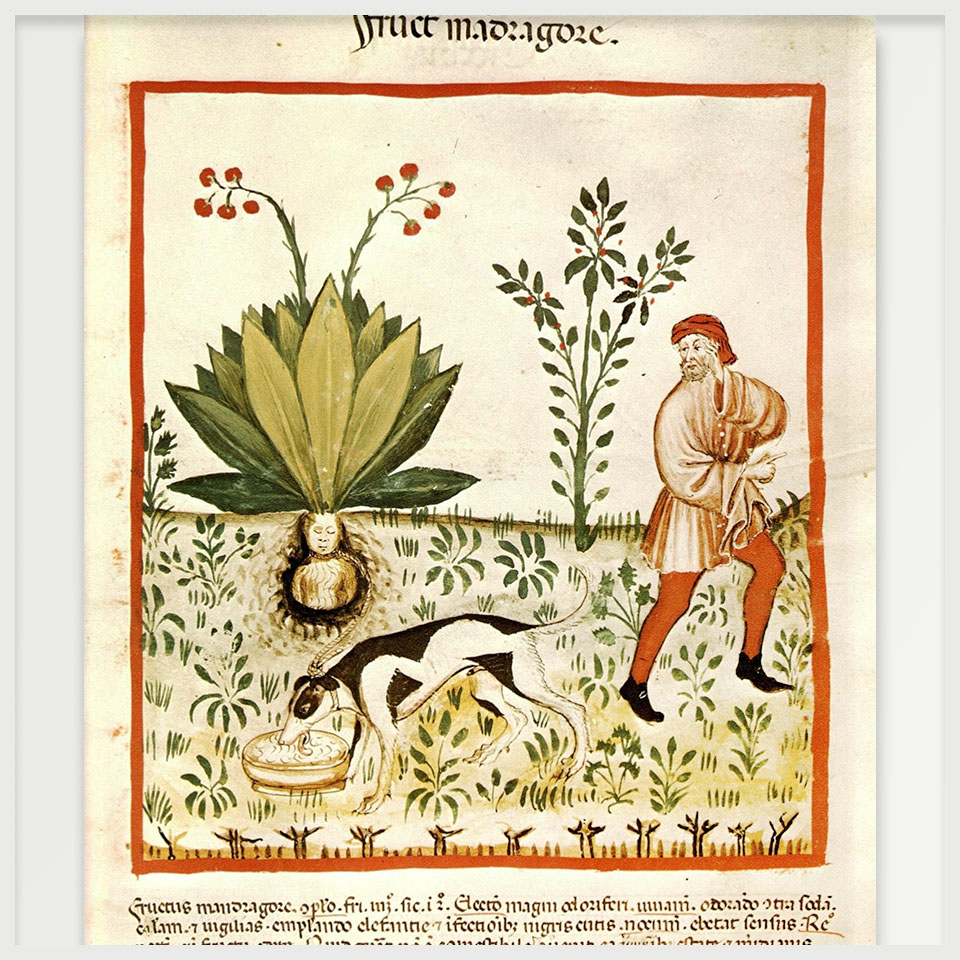
Mandrake Harvesting Illustrated in the Tacuinum Sanitatis manuscript, 1390
Pliny borrowed a great deal from Theophrastus and the account found in his Natural History of the practices of the root diggers and the harvesting of the mandrake in particular is one indication of this: “Those who are about to dig mandragora avoid a wind blowing in their faces; first they make three circles with a sword, and then dig looking toward the west” (Pliny quoted in Randolph: 1905, 490). We can notice however that Pliny says nothing of the “great many aphrodisiac formulas” that Theophrastus mentions in his account of the practices of the rhizotomes. Randolph suggests that “the omission by Pliny of any reference to aphrodisiac formulas is easily explained by his declaration that he will say nothing in his work about aphrodisiacs or magic spells except what may be necessary to refute belief in their efficacy” (Randolph: 1905, 490). This stance again speaks to the differences that existed in the ancient world between those who subscribed to the views and practices of natural magic and those who saw such a worldview as a breed of madness that must be rejected and defeated.
Aphrodisiacs were highly valued in Mediterranean herbal traditions, and one of the greatest of all of the aphrodisiacs was the mandrake. Rätsch comments that “in ancient times, the primary ritual significance of the mandrake was in erotic cults” (Rätsch: 2005, 348). However, only poor quality source material describing this usage remains and so detailed information about these practices is not available to us. Apart from its uses as an aphrodisiac, the mandrake was also widely used in medicine. Dioscorides:
A juice is prepared from the cortex of the bark by crushing this while fresh and pressing this; it must then be placed in the sun and stored in an earthen vessel after it has thickened. The juice of the apples is prepared in a similar manner, but this yields a less potent juice. The cortex of the root that is pulled off all the way around is put on a string and hung up to store. Some boil the roots with wine until only a third part remains, clarify this and then put it away, so that they may use a cup of this for sleeplessness and immoderate pain, and also to induce lack of sensation in those who need to be cut or burned themselves. The juice, drunk in a weight of two obols with honey mead, brings up the mucus and the black bile like hellebore; the consumption of more will take life away (Dioscorides quoted in Rätsch: 2005, 348).
The root diggers would only dig up the mandrake on the “day of Venus”, Venus of course being the Goddess of Love, which further suggests that one of the greatest virtues attributed to the mandrake in the ancient world was as an aphrodisiac, an agent in love magic/erotic rites (Randolph: 1905, 494). The mandrake is well known for its anthropomorphic appearance, and it is common in herbal traditions from around the world to attribute special healing powers to plants that resemble the human form (one can also think of the enormous sums that are paid in China even today for ginseng roots which look like human beings). Dioscorides and Pliny both make reference to a “male” and a “female” species of the mandrake but as Randolph clarifies “these terms, which the ancients applied to many plants, have nothing to do with sex, but signify more robust species (i.e., those having larger leaves, roots, etc., and attaining a greater height) and their opposites” (ibid).
The Goddess Circe
As we can see, herbal medicine in ancient and renaissance Italy, and throughout the Mediterranean region as a whole, was indissociably bound up with the workings of the gods and nature spirits. The Goddess Circe possessed a tremendous knowledge of herbs and, in particular, was regarded as a master of poisons (pharmaka). Her most famous plant was called Moly. To this plant were attributed psychoactive and aphrodisiac properties. Dioscorides referred to the mandrake as circeon, Mandragora Circaea being the herb that Circe used to transform Odysseus’ boat crew into “pigs.” (Müller-Ebeling et al. interpret this scene not in a literal sense but as an erotic transformation. The authors quote Apollonius: on the island of Circe “beasts, not resembling the beasts of the wild, nor yet like men in body, but with a medley of limbs went in a throng…such creatures, compacted of various limbs, did earth herself produce from the primeval slime…in such wise these monsters shapeless of form followed Circe” (Apollonius quoted in Müller-Ebeling: 2003, 117)). 19th and 20th century interpreters of the ancient literature (such as Dierbach and Kreuter) also take the Moly of Circe to be the mandrake. Theophrastus claimed that Circe lived in Lazio, a region in west-central Italy, where “the special medicinal herbs” were produced (Theophrastus quoted in Müller-Ebeling: 2003, 116). The sacred mountain of Circe, Monte Cicero, can still be visited today, on the Italian coast above Sicily. The early poet Aeschylus, according to Pliny, “declared that Italy abounds with potent herbs, and may have said the same of Circeii where she [i.e. Circe] lived. Strong confirmatory evidence exists even today in the fact that the Marsi, a tribe descended from Circe’s sons, are well-known snake-charmers” (Pliny quoted in Müller-Ebeling: 2003, 116).
Circe, goddess of death and guide of souls, was worshipped in groves. Apollonius notes that Circe’s groves, where executions were carried out, were lined with willows (Salix alba) and osiers/tamarisks (Tamarix spp.). Tamarisks and willows are well known medicinal trees. “The willow, or, more precisely, the white willow, was used for birth control; thus it was a typical witches’ plant” (Müller-Ebeling, 117). Two other plants sacred to Circe are the alder (most probably Alnus glutinosa) and juniper (Juniperus communis or Odorata cedrus, as it is recorded in Virgil’s Aeneid). Concerning the alder tree, it was said to surround Circe’s island (Aeaea or Eëa), located just south of Rome. Müller-Ebeling et al. comment:
“We can assume that there had been an archaic alder cult that by the Hellenic times had already been suppressed. Alders were considered transformed sisters of Phaeton, the son of Helios and brother of Circe” (Müller-Ebeling: 2003, 117). Juniper was Circe’s sacred incense and “therewith it is in the vicinity of archaic shamanism. Juniper is one of the oldest incense materials of the Eurasian shamans” (ibid).
Let us conclude our discussion of Circe by noting that though she has been described as compassionless and called the mother of darkness and horror, this noble sorceress was originally worshiped as a healing Goddess. As Giordano Bruno writes:
Ah, if only it pleased the sky, that for us today, like once long ago in happier centuries, this ever magical Circe would appear, who would be able to put an end to things with plants, minerals, poisons, and the magic of nature. I am certain, that despite her pride she was merciful with regards to our misery (Bruno: 1998).
Diana (Artemis) and Pan. Engraving after Annibale Carracci
What We Can Learn From This Symbiosis
To conclude, let us illustrate with another example just how bound up the practices of the healing arts were with the pagan pantheon of Gods and Goddesses – and consider how we can still learn from these sources of inspiration from the mythological imagination of the Renaissance. Consider Artemis/Diana, a woodland Goddess who served as the archetypal herbal healer throughout antiquity. She has very close ties to the animals of the forest, and oversees the wild hunt. Artemis is the goddess of the moon, the fierce protectress of the wild and of all of the life which courses through it, and it is she who governs the cycles of fertility and birth. Artemis’ garden is wild nature. Her role as a great shamanic healer is further brought to light through her representation as the “great she-bear, Ursa major, ruler of the stars and protector of the axis mundi (pole of the world) marked by the pole star at the centre of the constellation of Ursa Major” (Brooke: 1992). Artemis is closely associated with the artemisia plants, such as mugwort and wormwood (plants that help to enhance the clarity of consciousness, promote emotional resilience, and foster a refined sensitivity to and deepened awareness of our place in the world and our interactions with human and other-than-human nature). As explained in the Medicina Antiqua:
“There are three types of Artemisia. All three and their healing effects were discovered by the Goddess Diana. She transmitted this medicine chest to the centaur Chiron, who was the first to transform it into medicine. This is why these plants carry the name of Diana, or rather Artemisia” (Medicina Antiqua 13, fol. 32r).
When we read this and related sentiments, it becomes clear that without Artemis the tradition and practices of the Renaissance magi-herbalists would be inconceivable.
Healing was, in the Renaissance traditions here under discussions, associated with the qualities of grace and beauty. Artemis/Diana was said to be exceptionally beautiful, her beauty being comparable even to that of Aphrodite. Psychologist Ginette Paris suggests that Artemis sanctifies “solitude, natural and primitive living to which we may all return whenever we find it necessary to belong only to ourselves” (Paris: 1986, 124). In her capacity as a huntress and archer, she can bestow upon us the wild, atavistic power that can be utilized to resist the forces of domestication and domination. Artemis is the great protectress of flora and fauna, and thus she has a special bearing on the ecological issues that face living beings on the Earth today. It would be wise to look to her when making choices that will affect the future of the natural world.
“There are obviously many ways of entering into therapeutic contact with nature, but solitude and identification with nature through falling water, trees, or animals are cues that our contact is with Artemis rather than Dionysus, Demeter, or Aphrodite” (ibid, 127). The waters of the mountains and streams are also under the care of Diana, and if we are to re-enliven our sacred relationship to this elemental force then “perhaps, afterward, the nymphs, naiads, and nereids would return to inhabit our imagination and teach us the necessary respect for the waters of Artemis” (ibid). Let us not forget the mythological traditions of healing and the great bearing they can have on contemporary consciousness, let us take heed not to neglect the great Pagan wisdom of the wild imagination.

Bible page depicting the prophet Ezekiel’s Vision, 1648
Footnotes:
1 Daniel Schulke claims that black hellebore is “a poison of decided infamy; all parts of the plant render up potent venoms” (Schulke: 2017, 132). An extract of the rhizome was used in antiquity and into the medieval era as a “utensil of murder, most notably by King Attalus III of Pergamos” (ibid). Black hellebore contains the glycosides heleborin and hellebrin, which are chemically related to telo-cinobufagin (venom found in some species of toad skin). These glycosides slow the heart rate and affect cardiac muscle in a similar way to foxglove. The Key of Solomon the King contains a recipe for an incense to be used as part of a “spell for vivifying a talisman with the genius of Saturn” containing the stalks of black hellebore along with alum, assafoetida, scammony, sulphur, and cyprus ash (ibid).
Works Cited:
- Brooke, Elisabeth. A Woman’s Book of Herbs. London: Aeon Books, 1992.
- Bruno, Giordano. Cause, Principle and Unity: And Essays on Magic. Cambridge: Cambridge University Press, 1998.
- Hillman, James. Re-Visioning Psychology. New York: Harper, 1976.
- Müller-Ebeling, Claudia, Rätsch, Christian, and Storl, Wolf. Witchcraft Medicine: Healing Arts, Shamanic Practices, and Forbidden Plants. Vermont: Inner Traditions, 2003.
- Paris, Ginette. Pagan Meditations. Connecticut: Spring Publications, 1986.
- Randolph, Charles Brewster. ‘The Mandragora of the Ancients in Folk-Lore and Medicine.’ Proceedings of the American Academy of Arts and Sciences, Vol. 40, No. 12 (Jan., 1905), pp. 487-537.
- Rätsch, Christian. The Encyclopedia of Psychoactive Plants. Maine: Park Street Press, 2005.
- Schulke, Daniel. Veneficium: Magic, Witchcraft, and the Poison Path. San Francisco: Three Hands Press, 2017.
- Silberman, Henri. ‘Superstition and Medical Knowledge in an Italian Herbal.’ Pharmacy in History, Vol. 38, No. 2 (1996), pp. 87-94
- Yates, Frances. ‘The Religious Policy of Giordano Bruno.’ Journal of the Warburg and Courtauld Institutes, Vol. 3, No. 3/4 (Apr. – Jul., 1940), pp. 181-207.
Illustrations/Images:
- Medicina Antiqua Illustration
- 17th Century Bible: (photo provided by Serena Mor)
- Veratrum album Illustration
- Mandrake Harvesting
- Diana (Artemis) and Pan
- Prophet Ezekiel’s Vision: (photo provided by Serena Mor)

